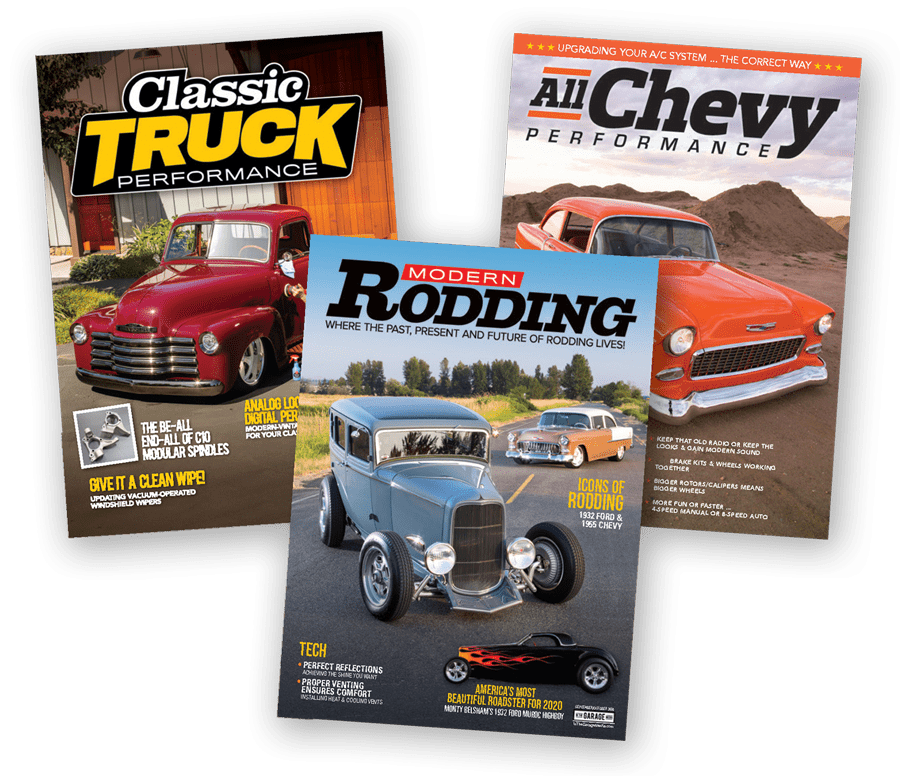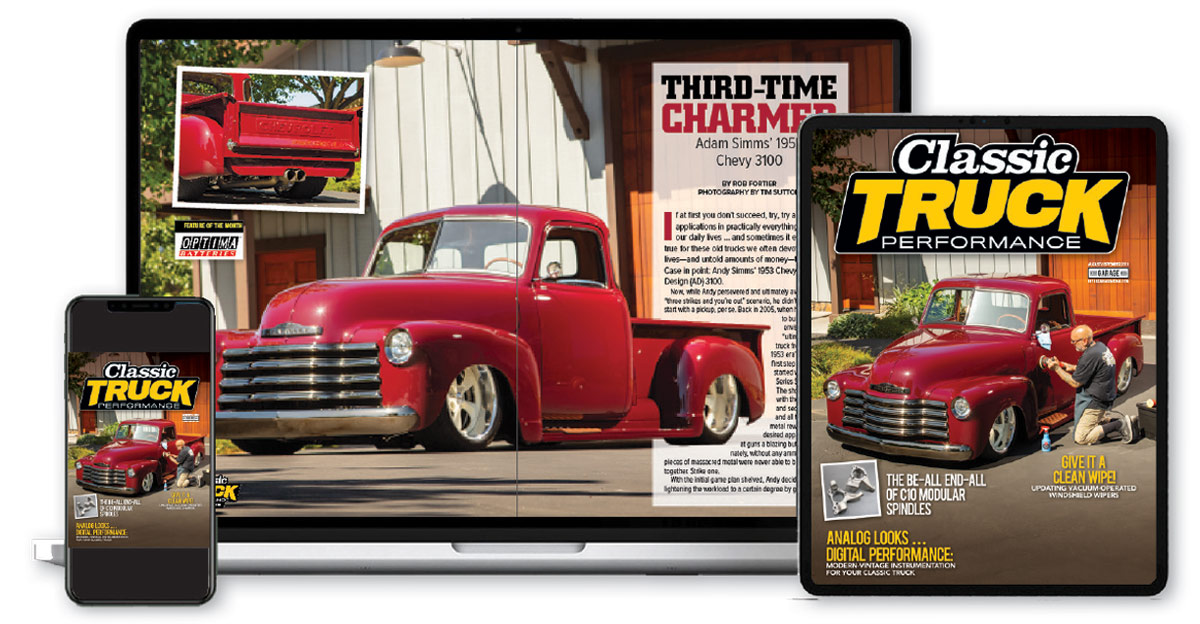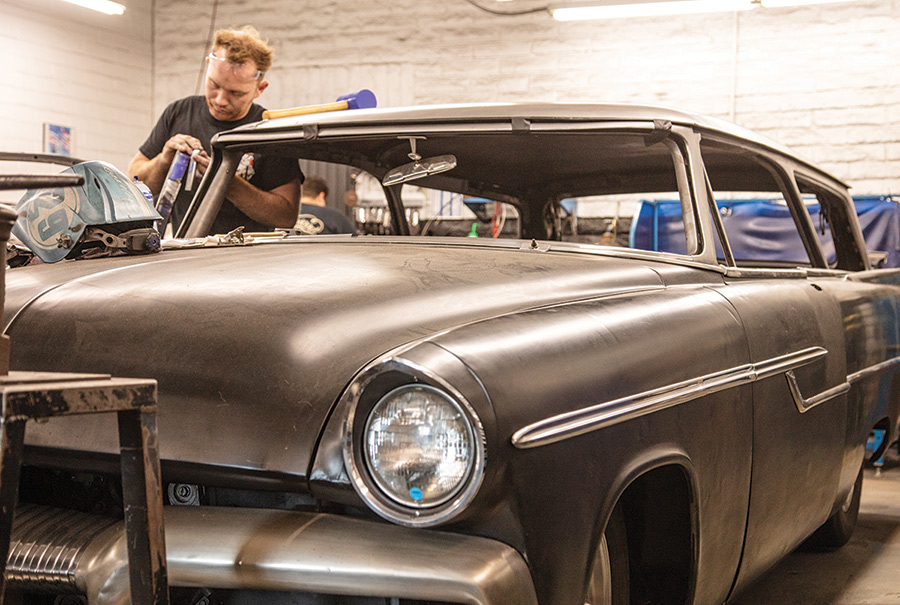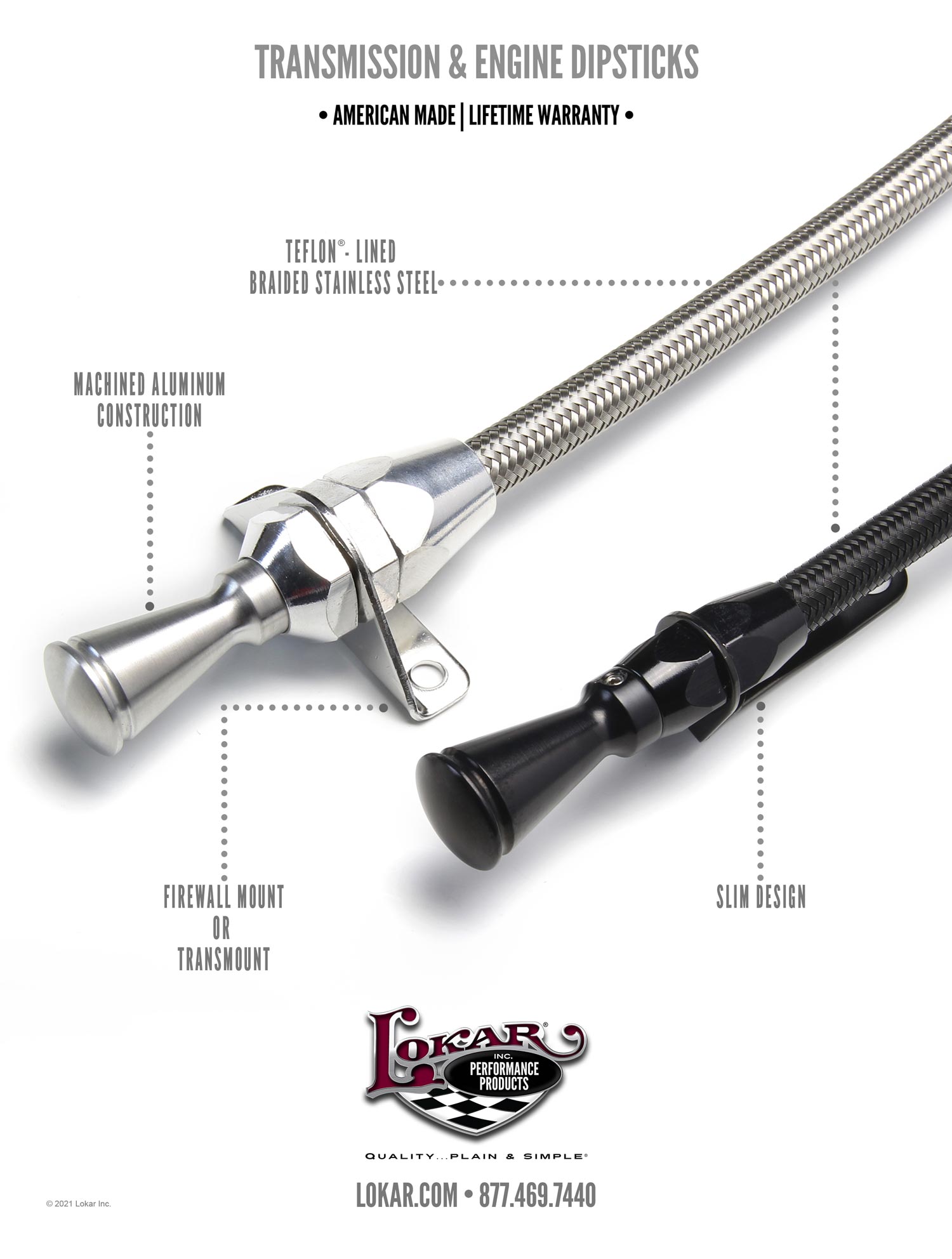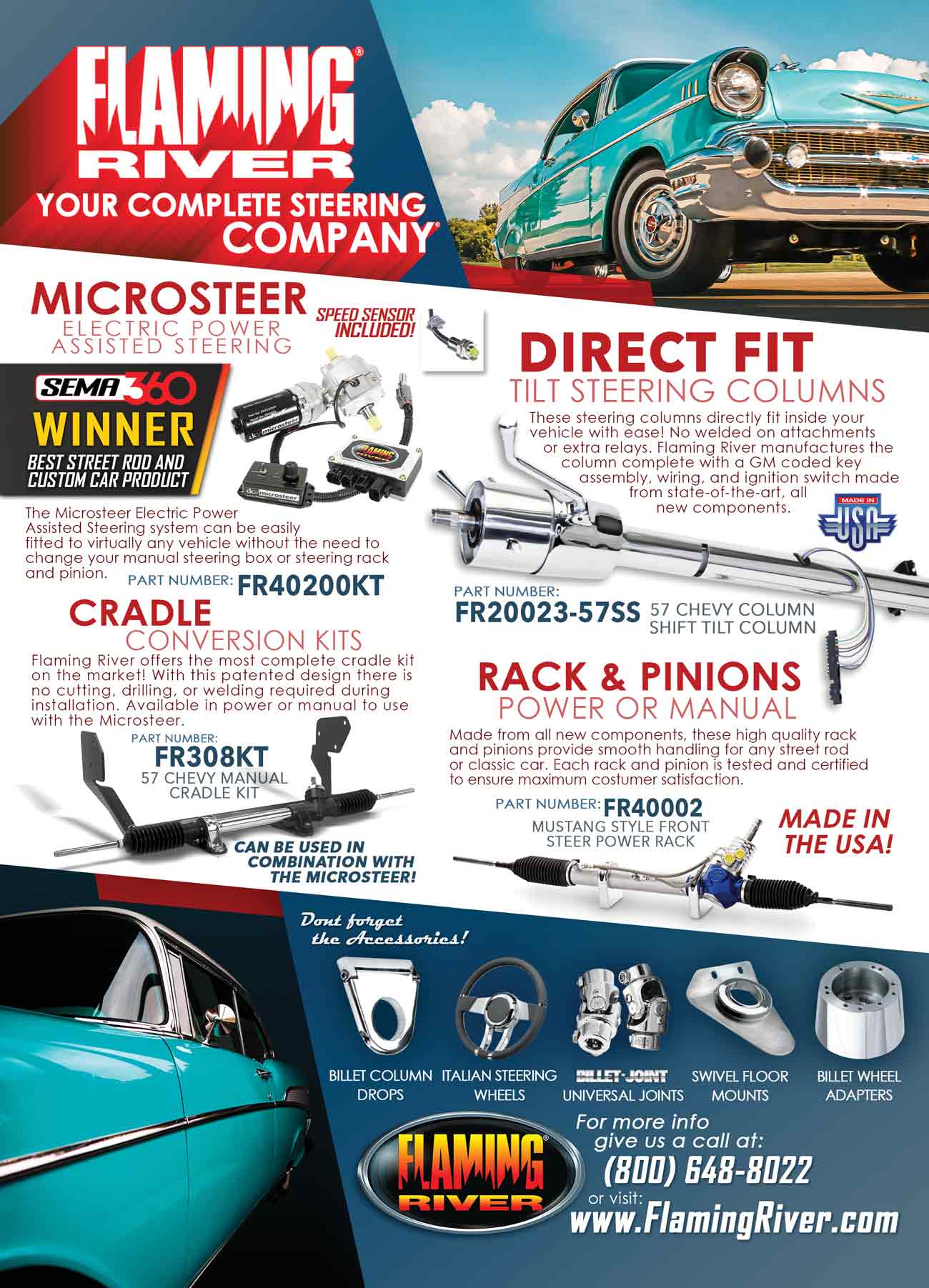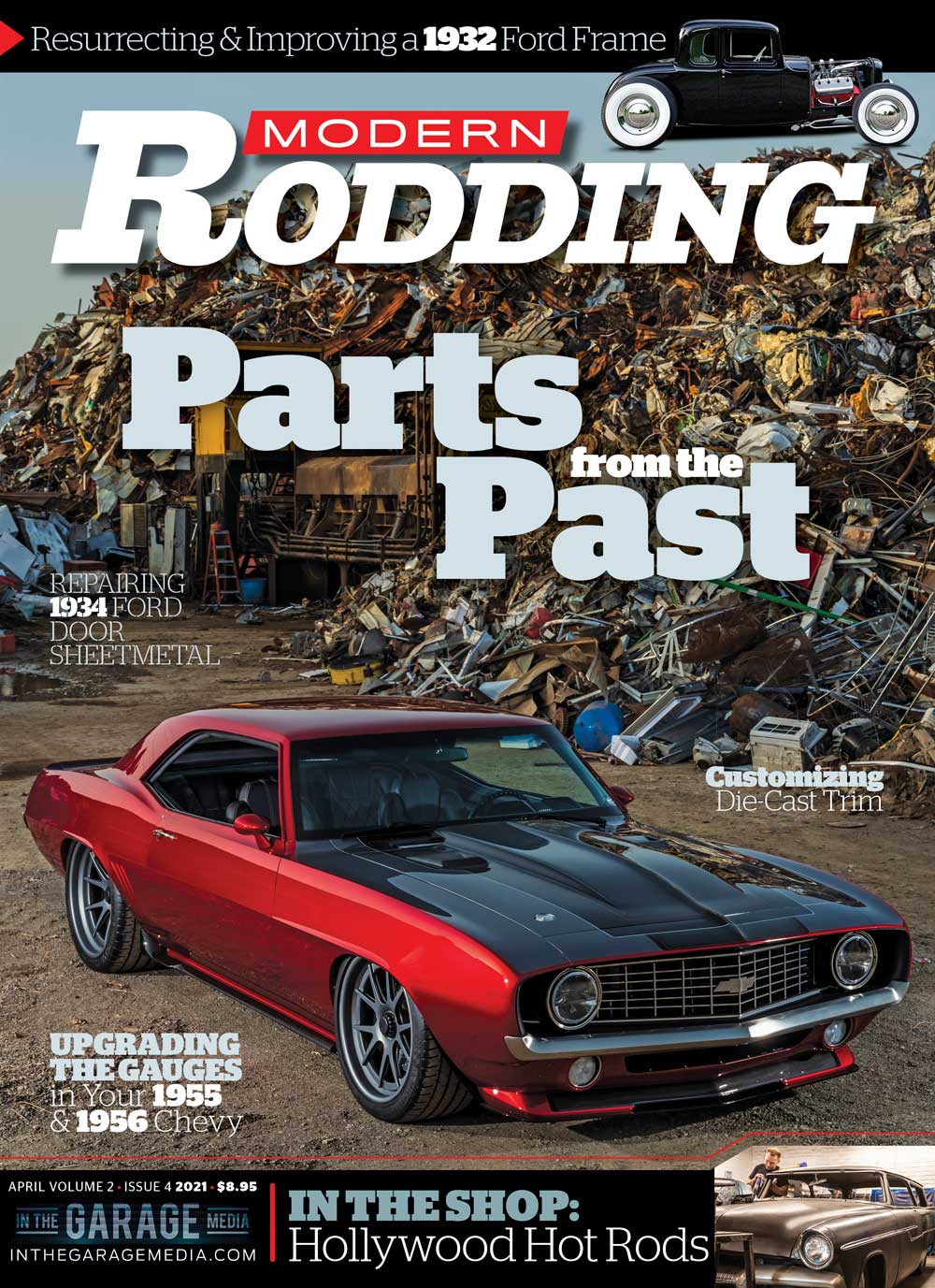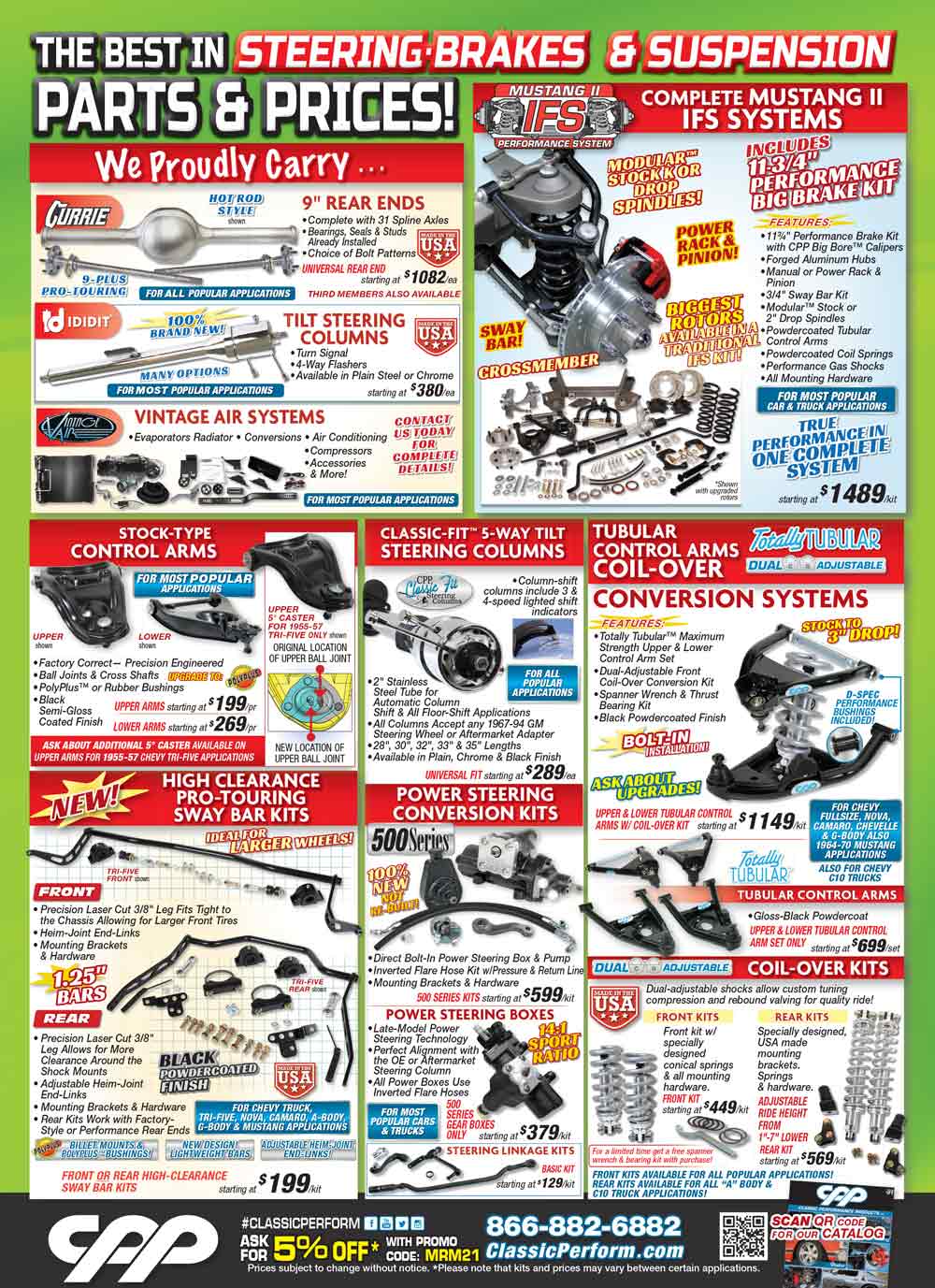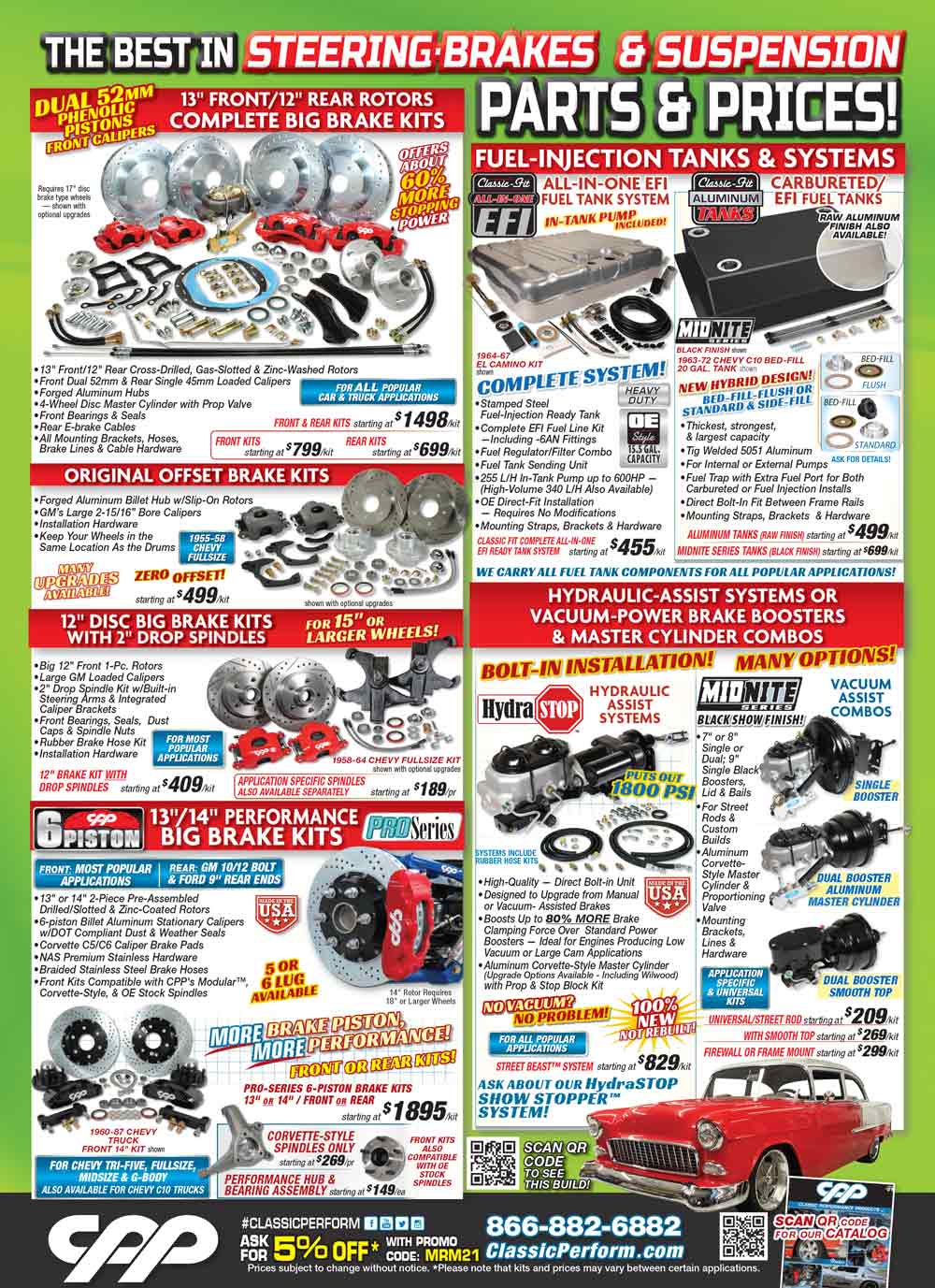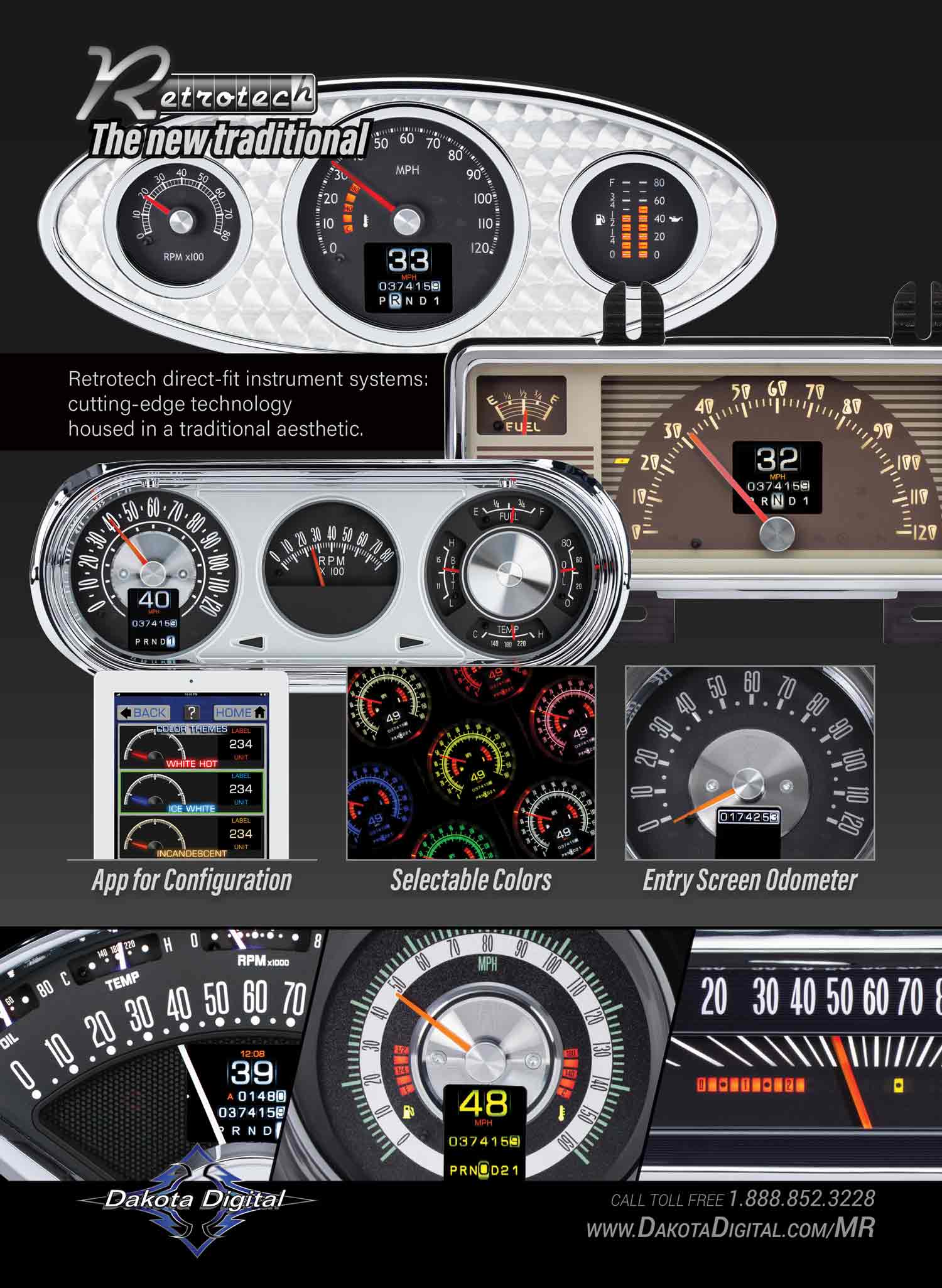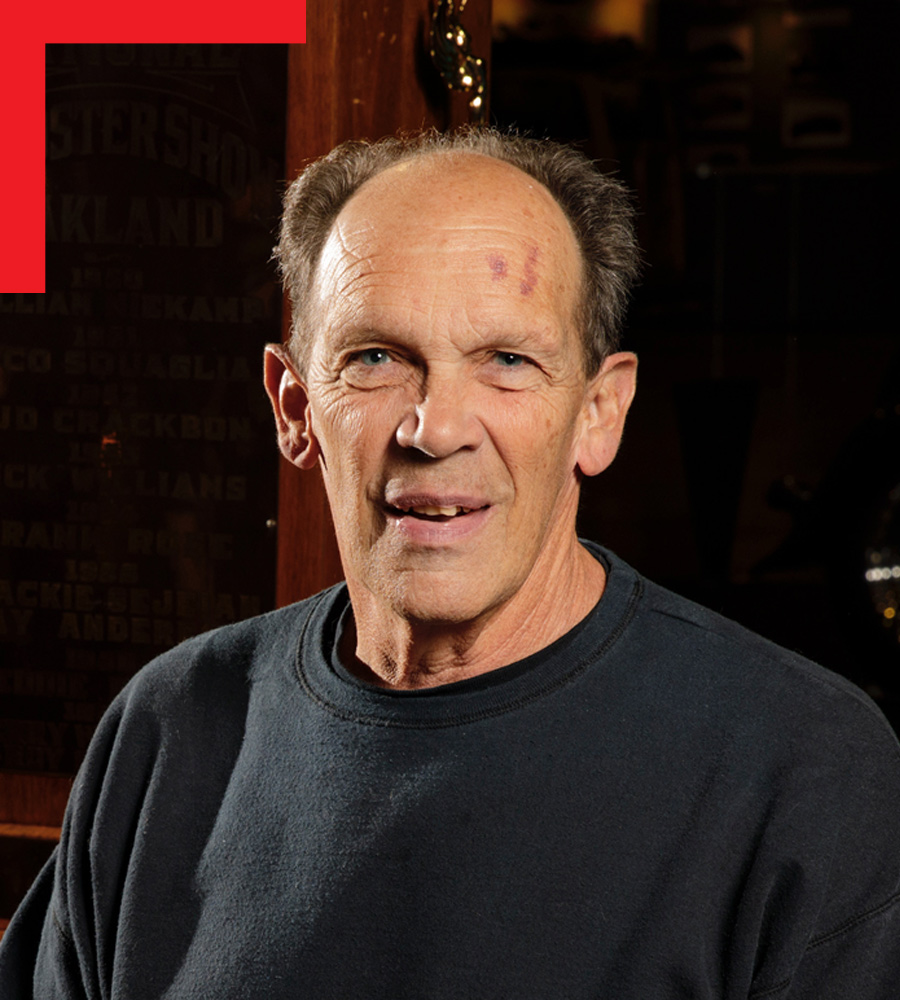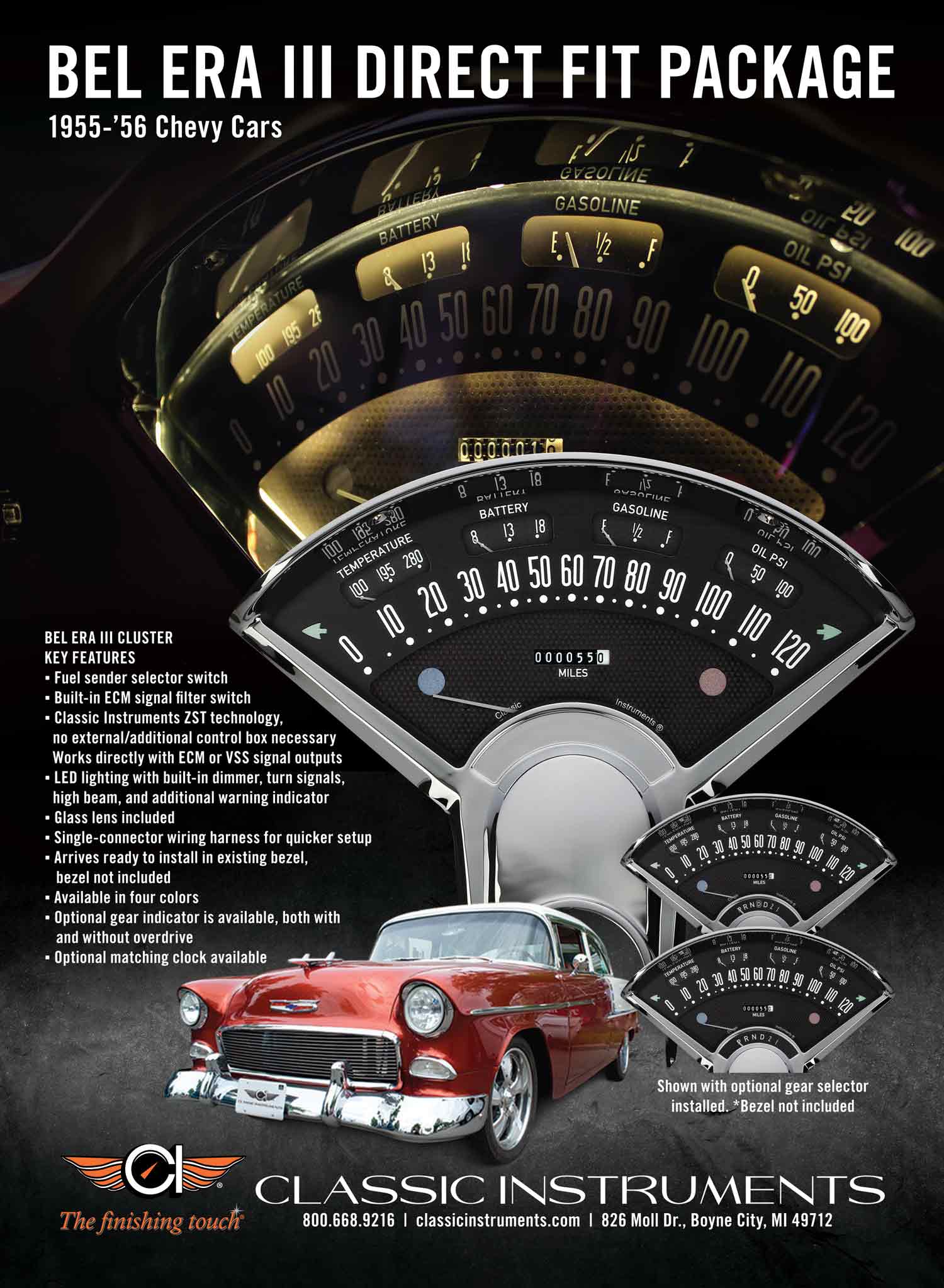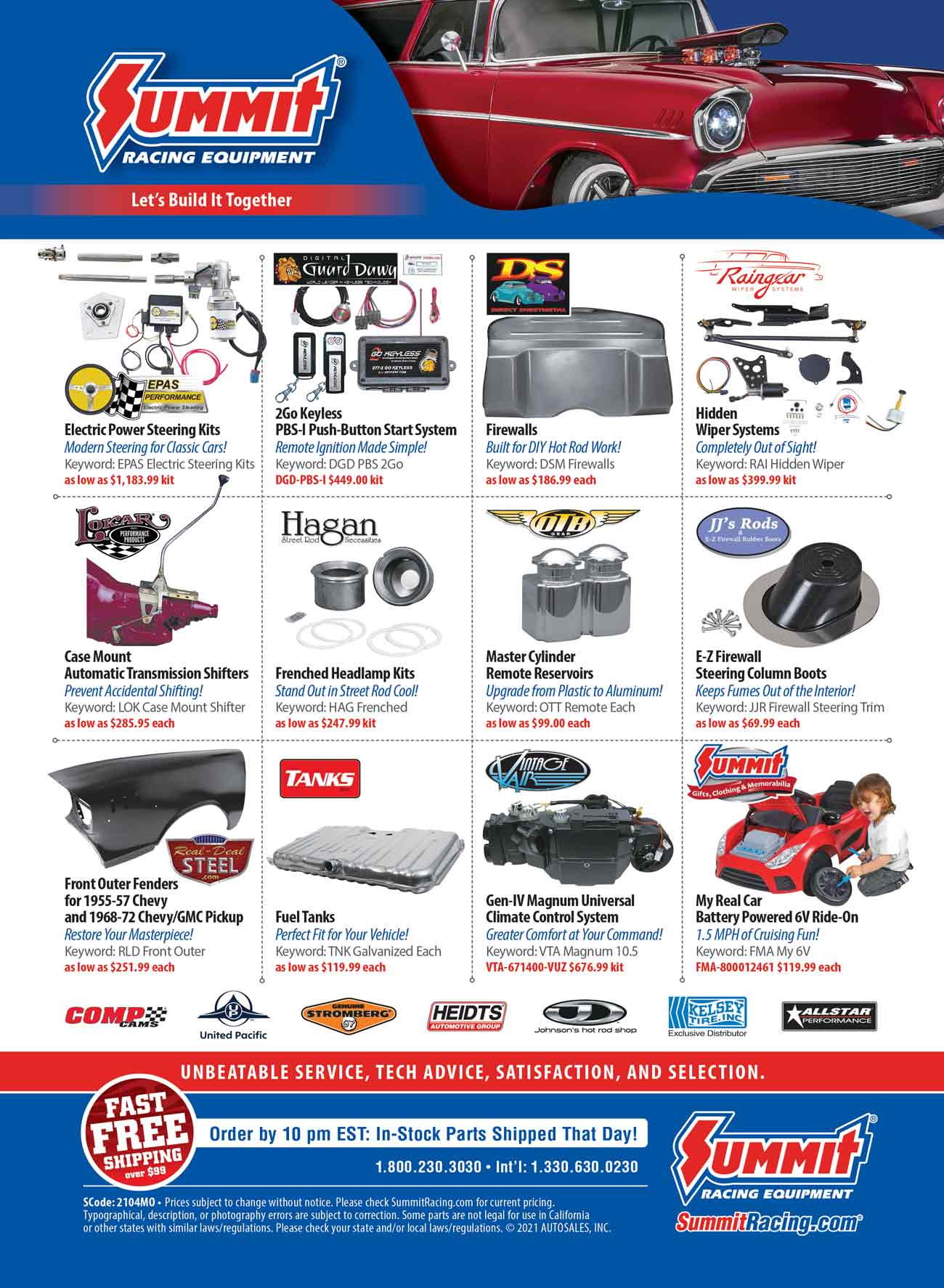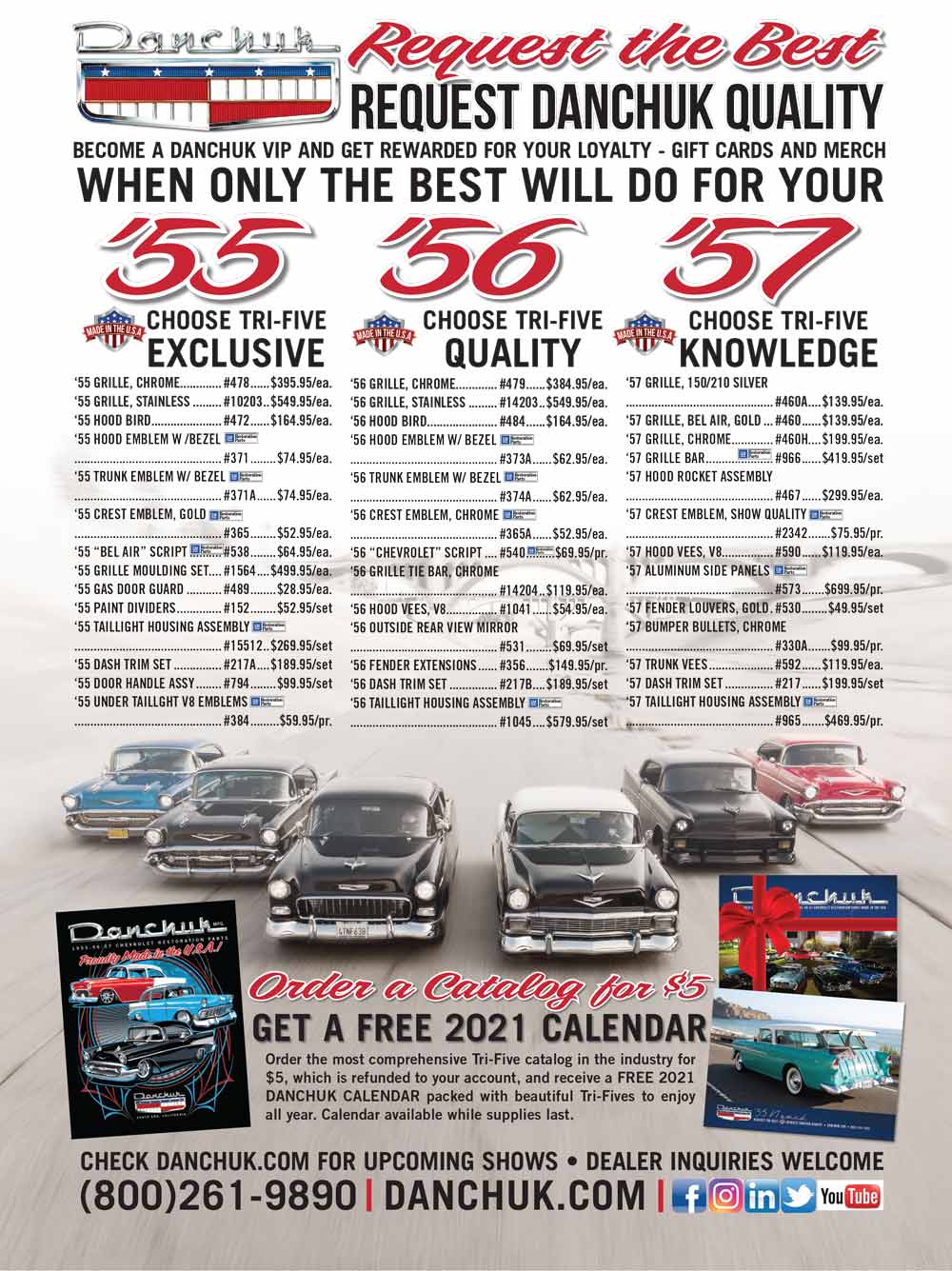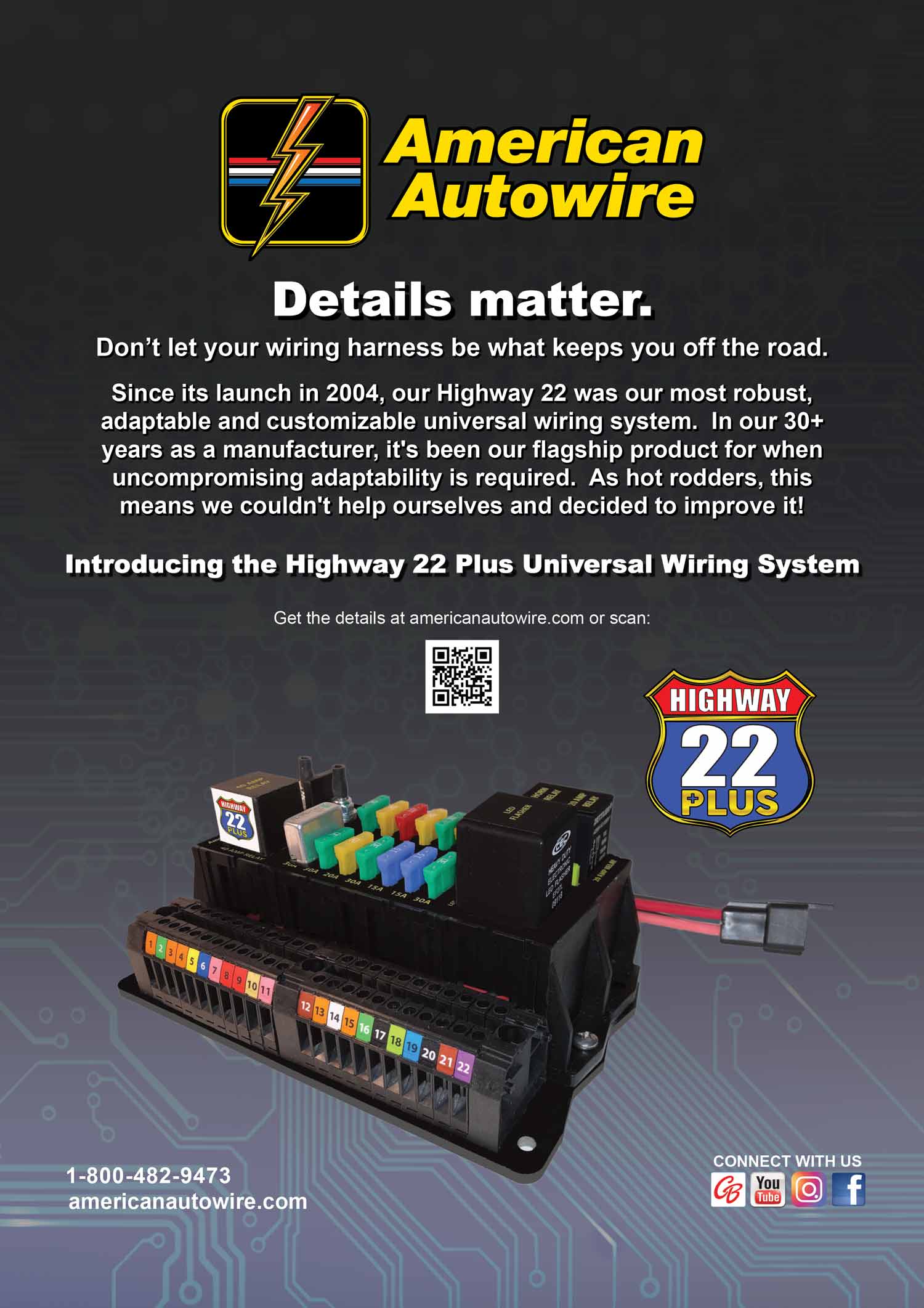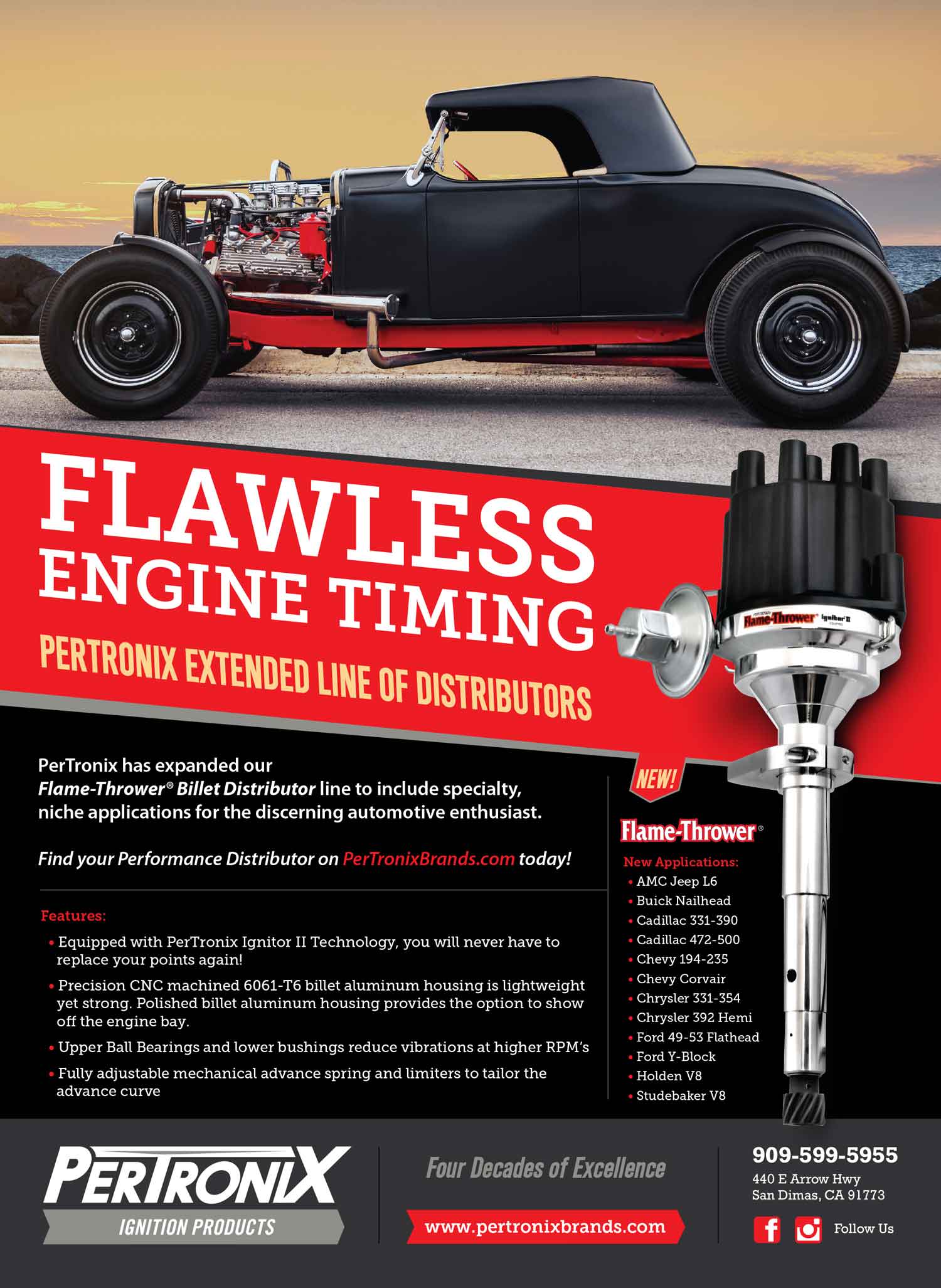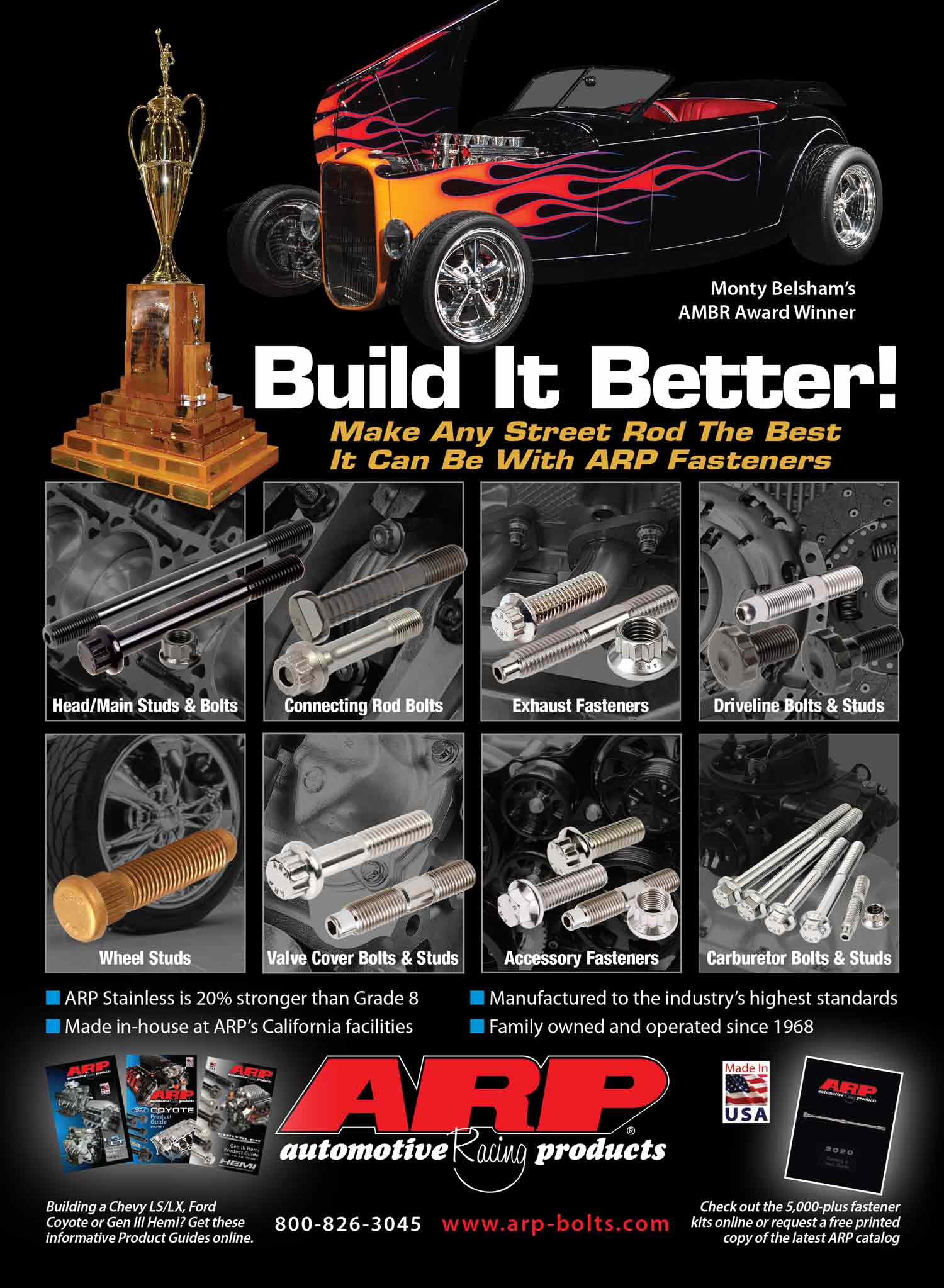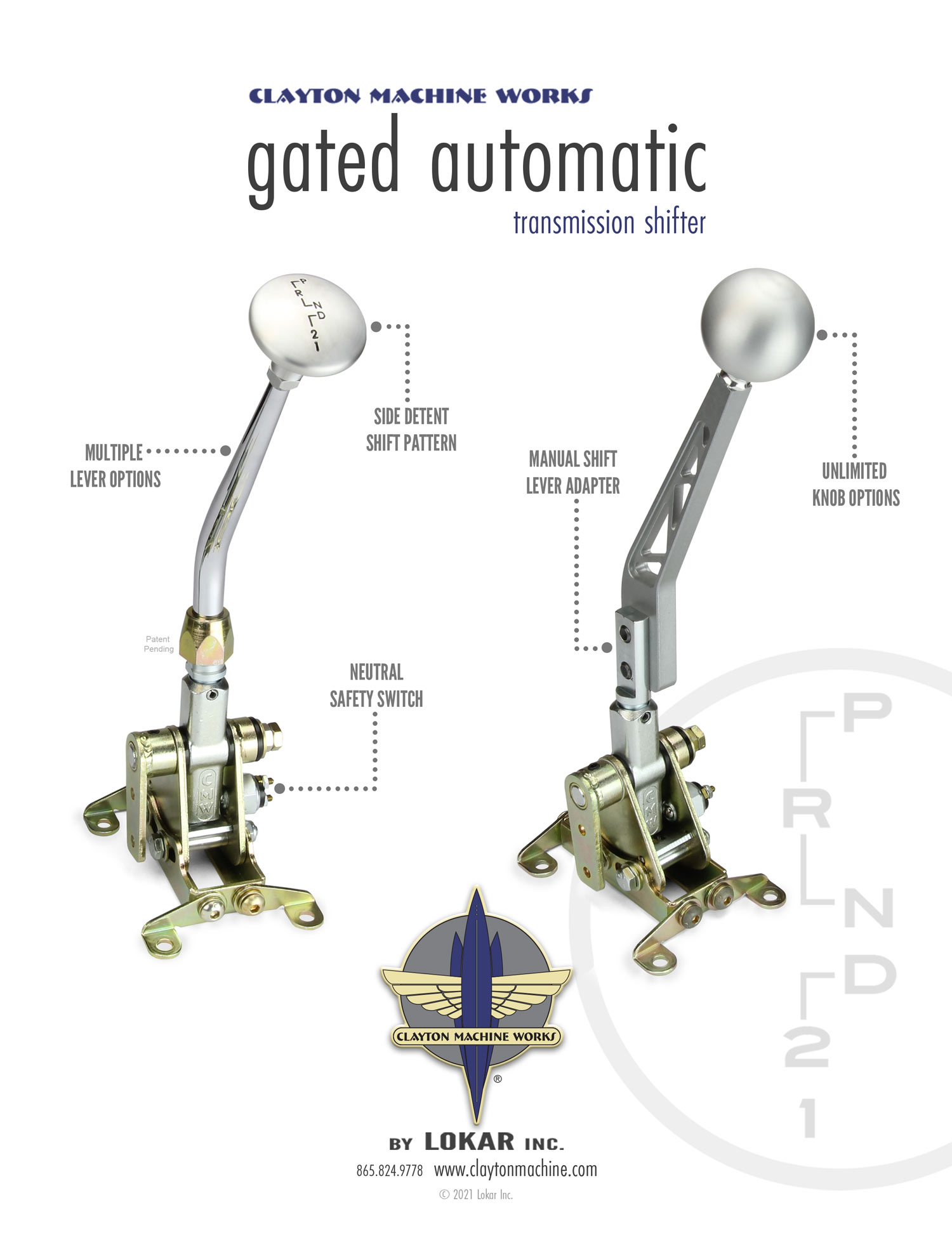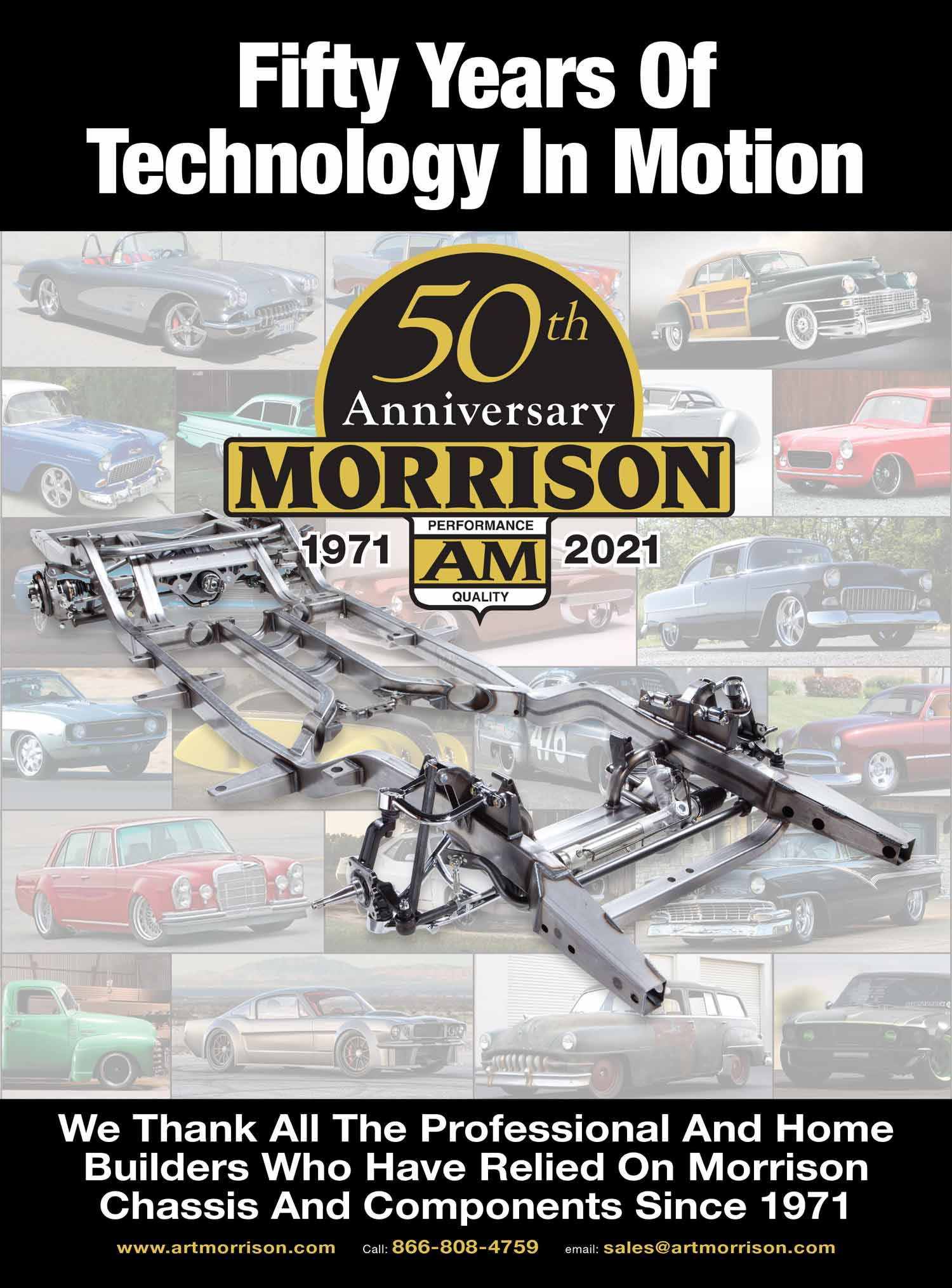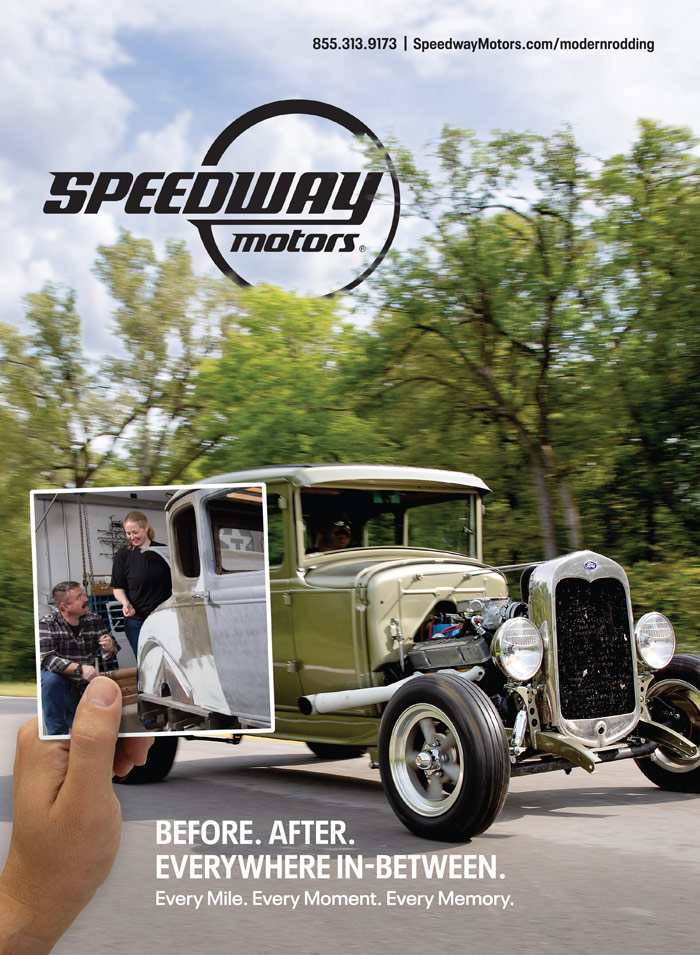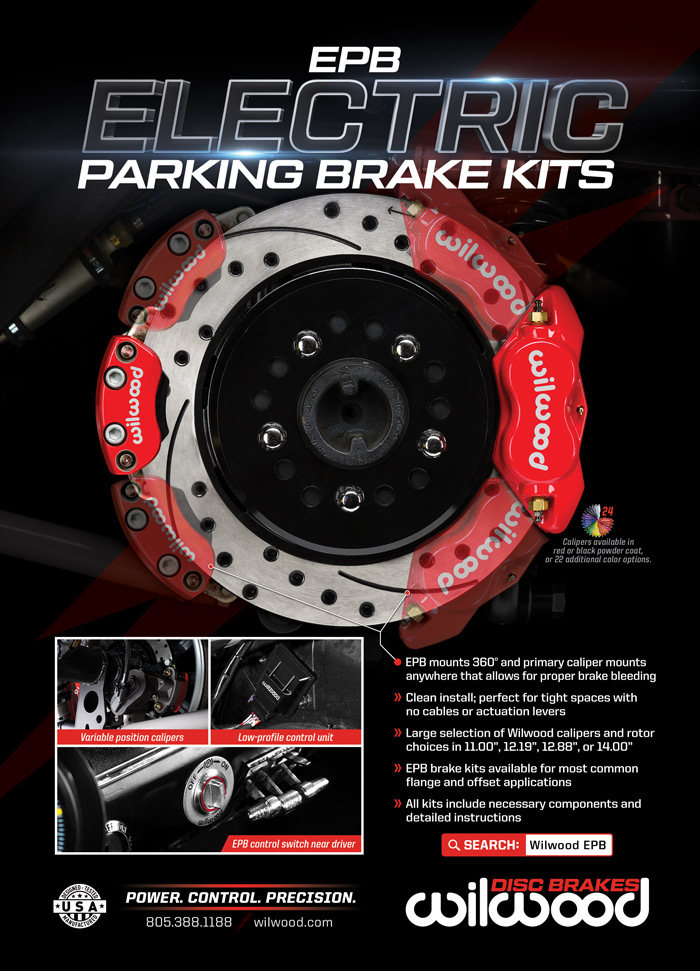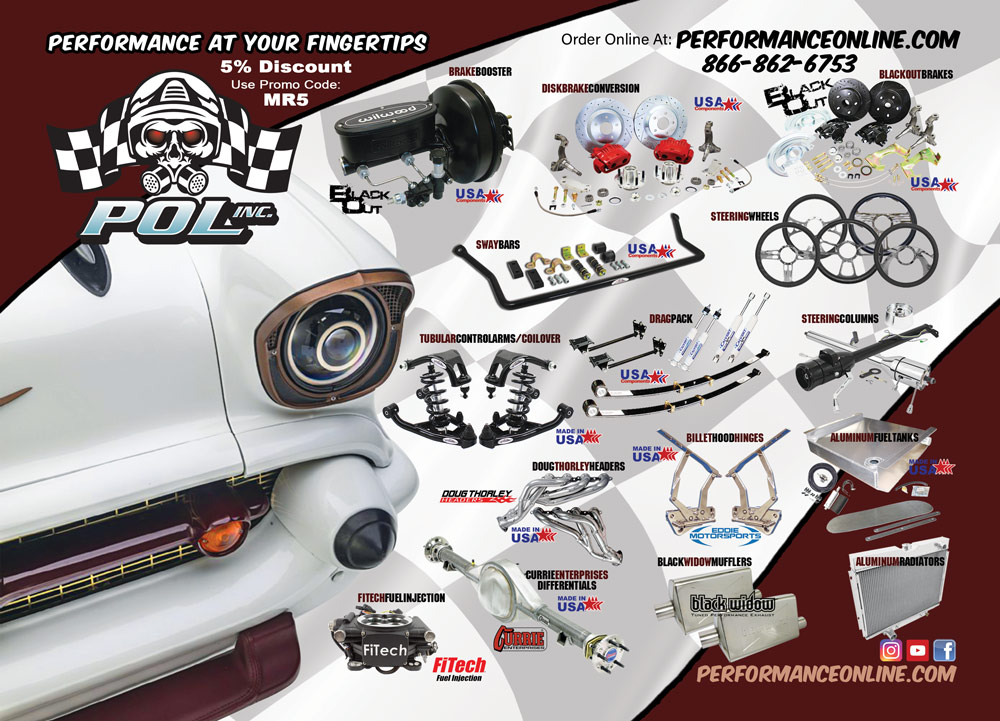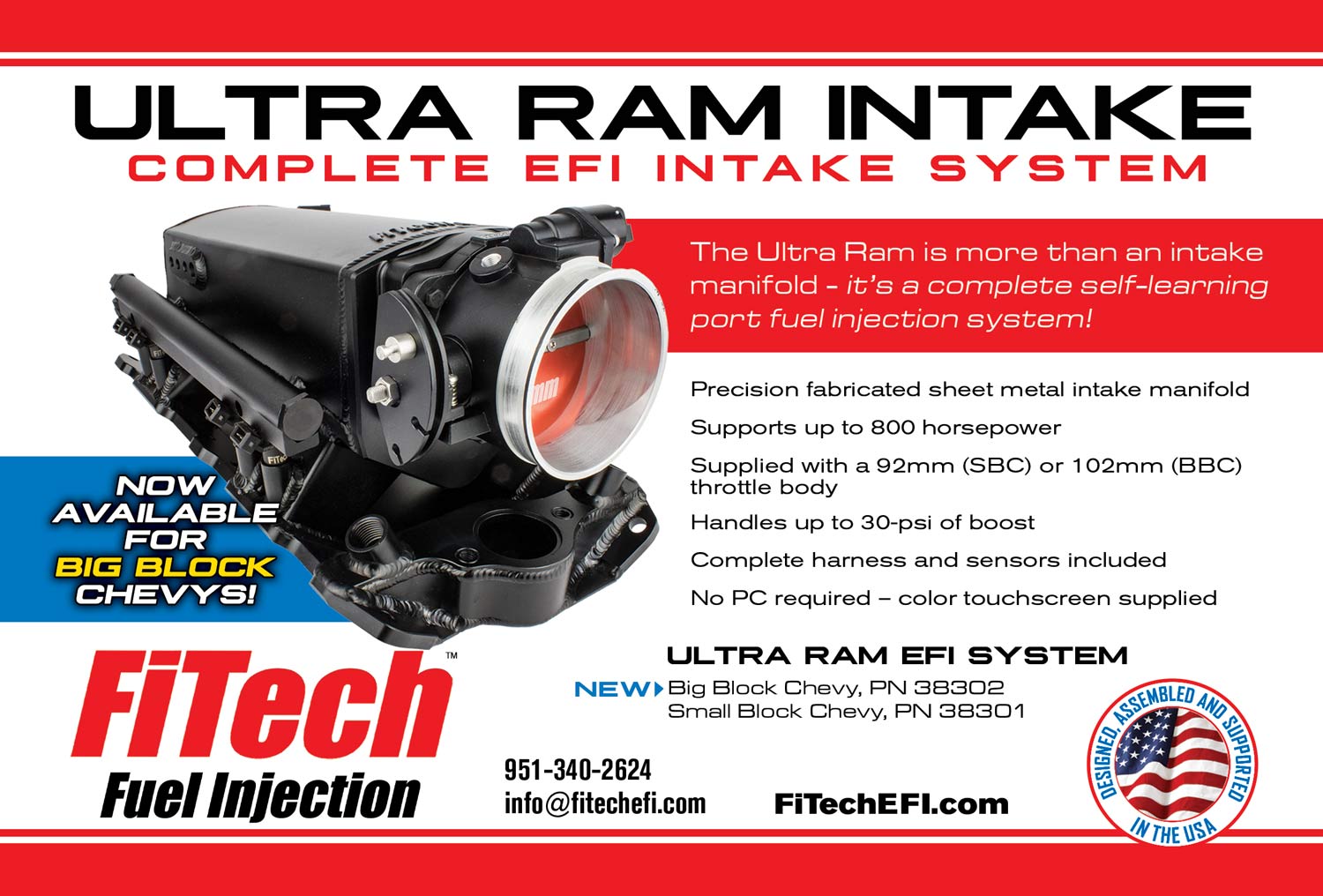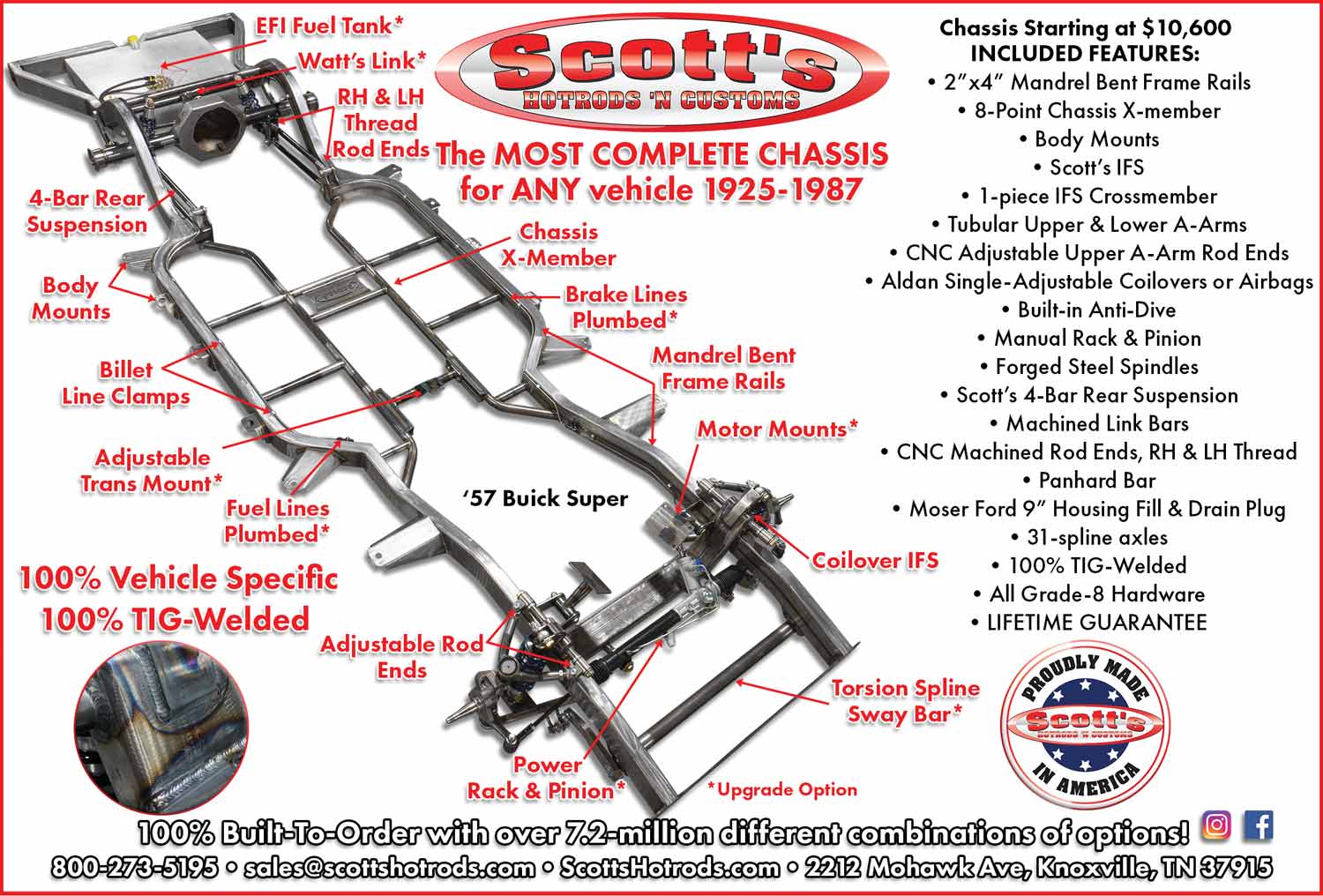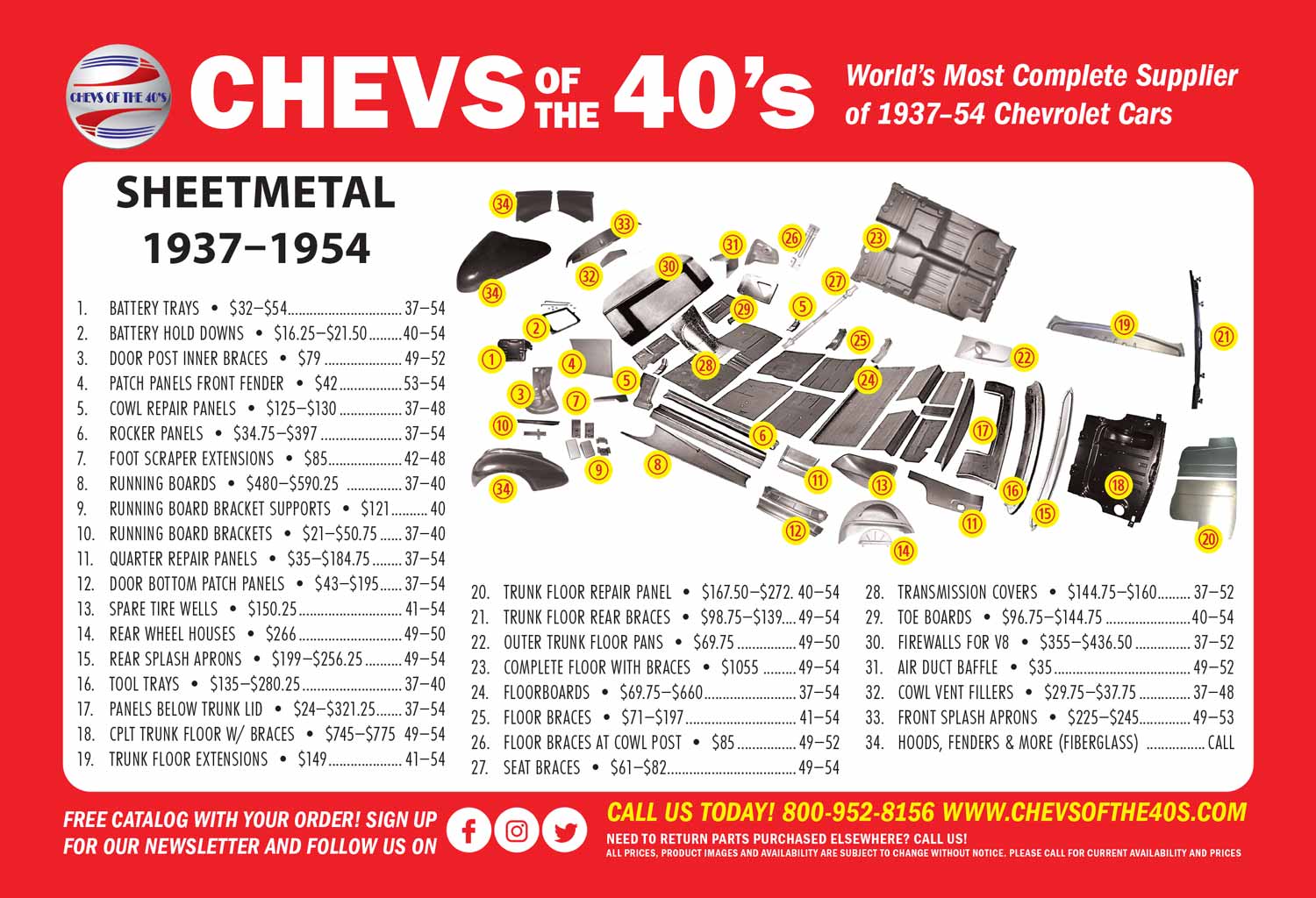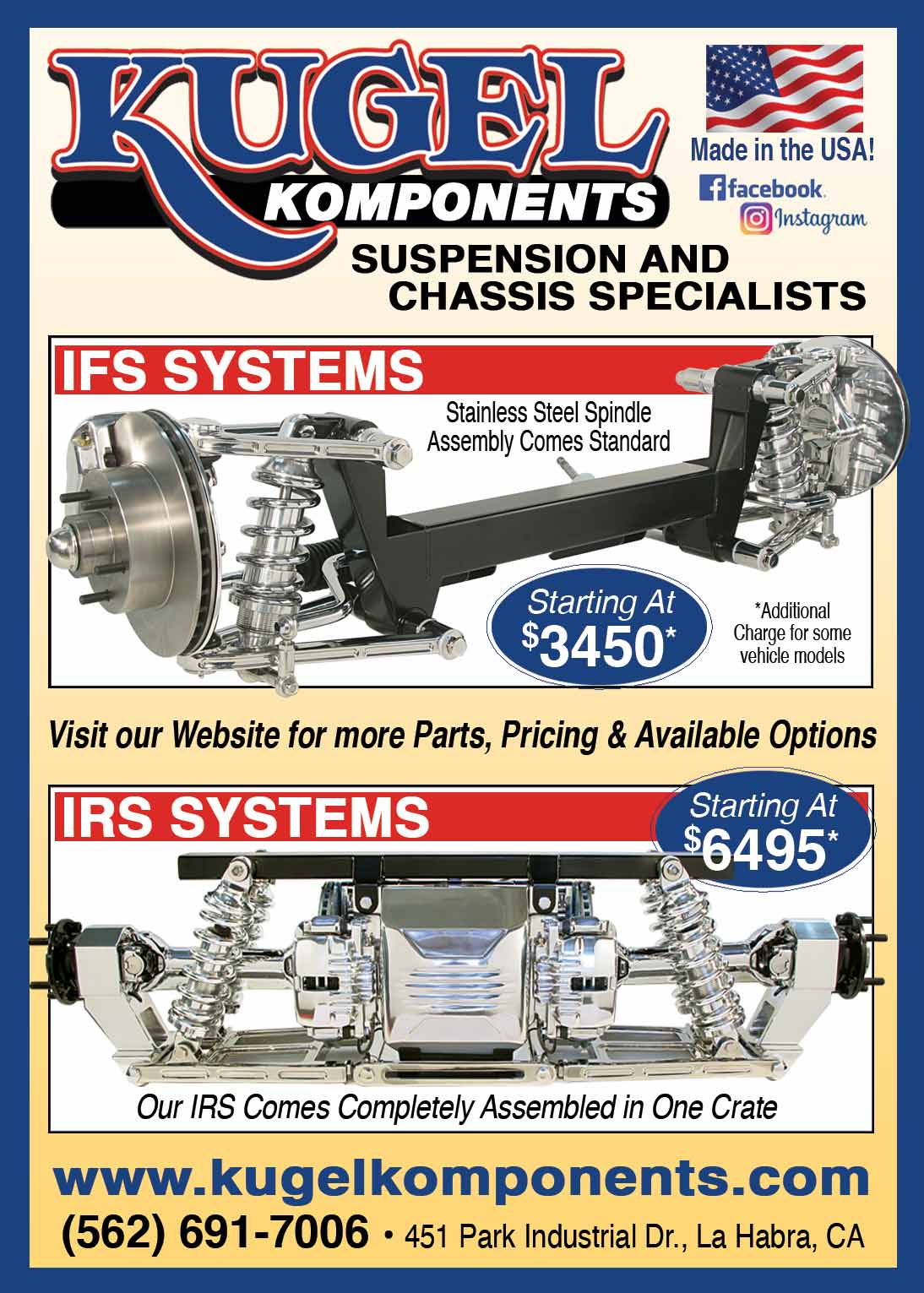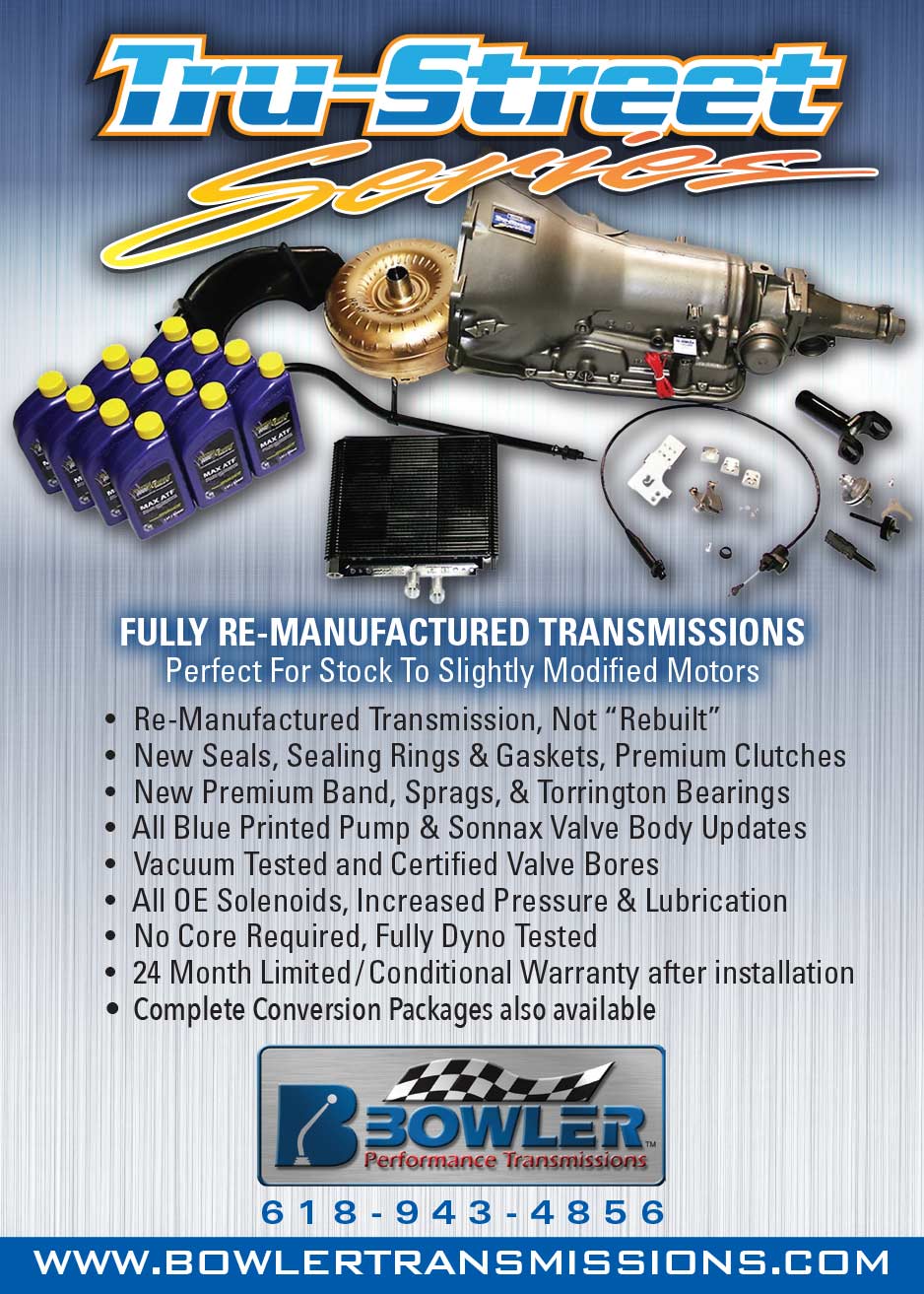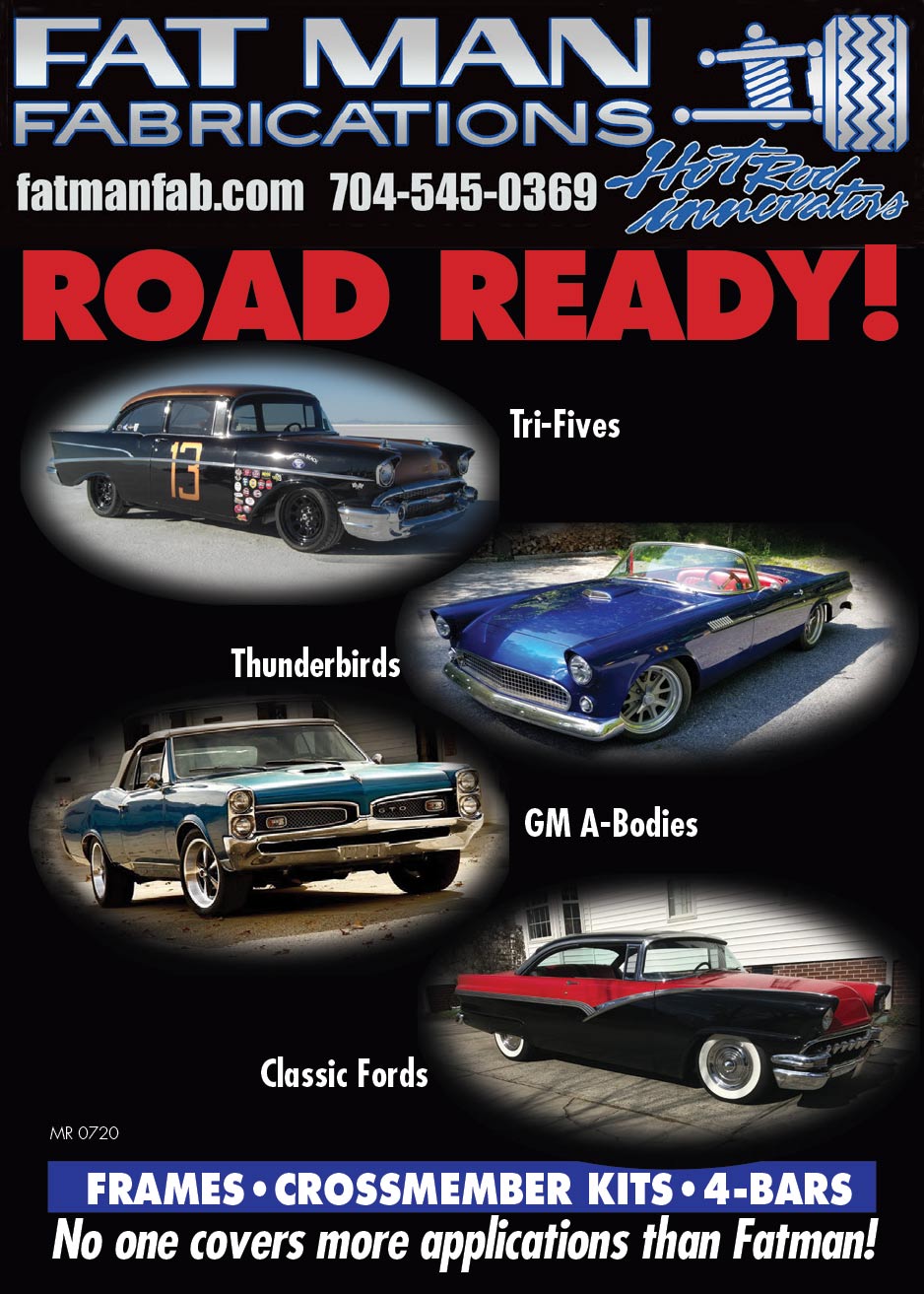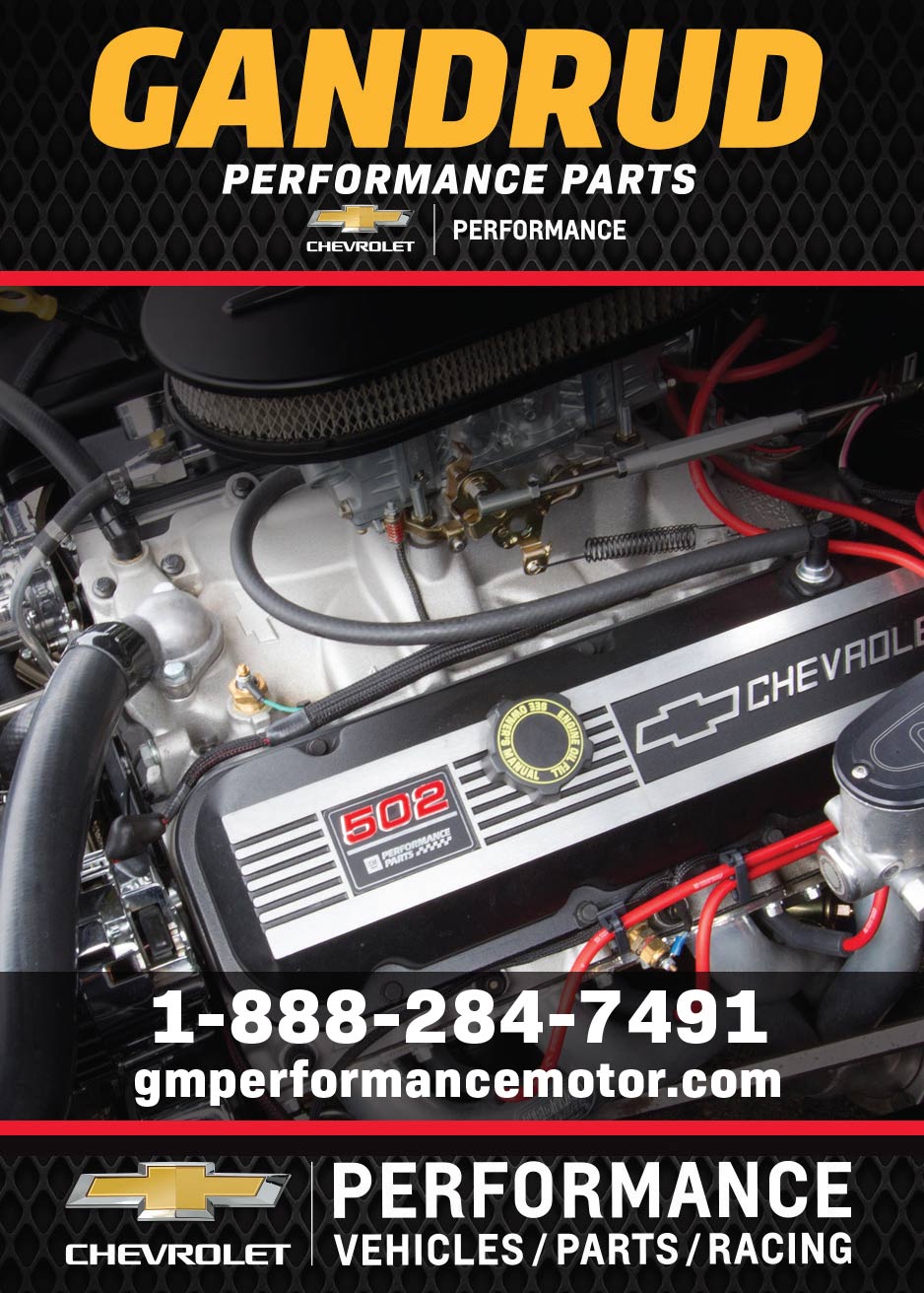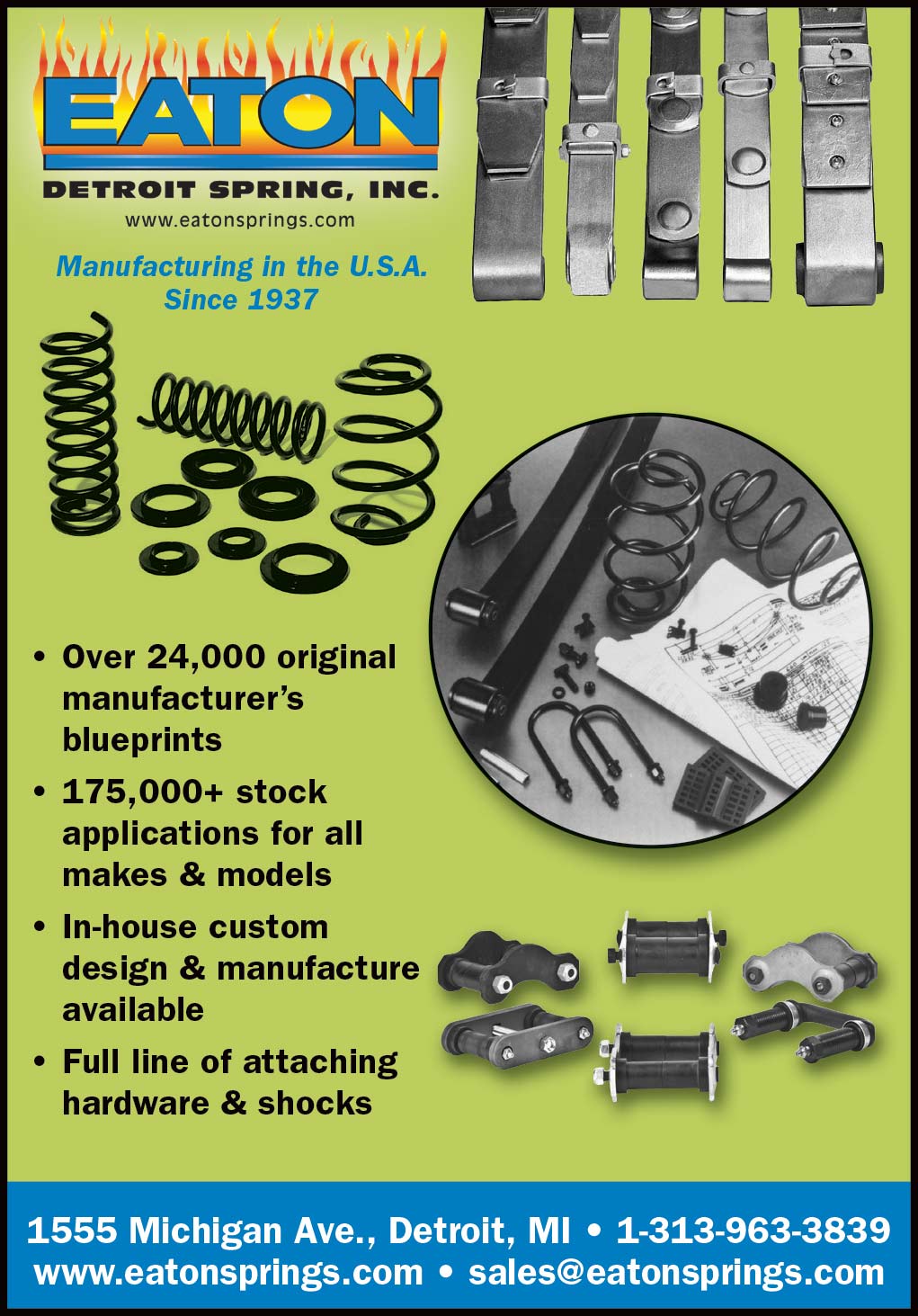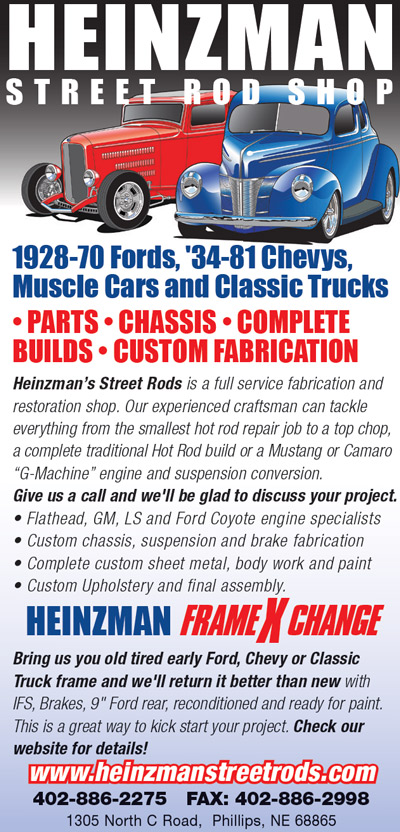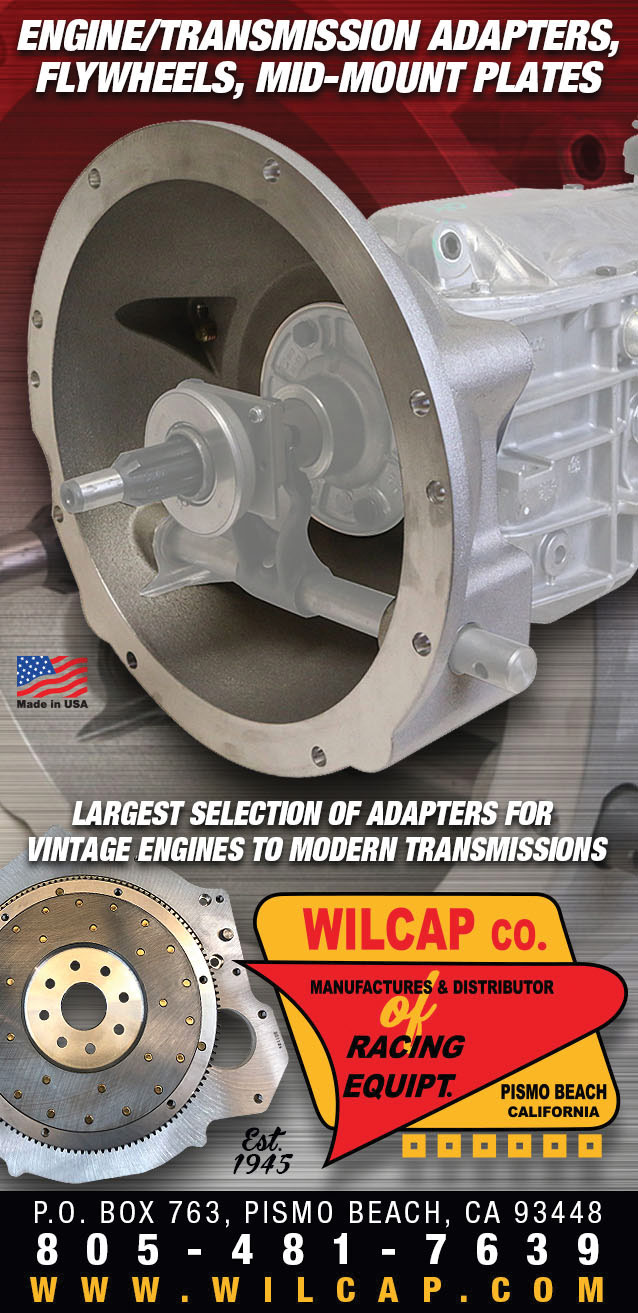

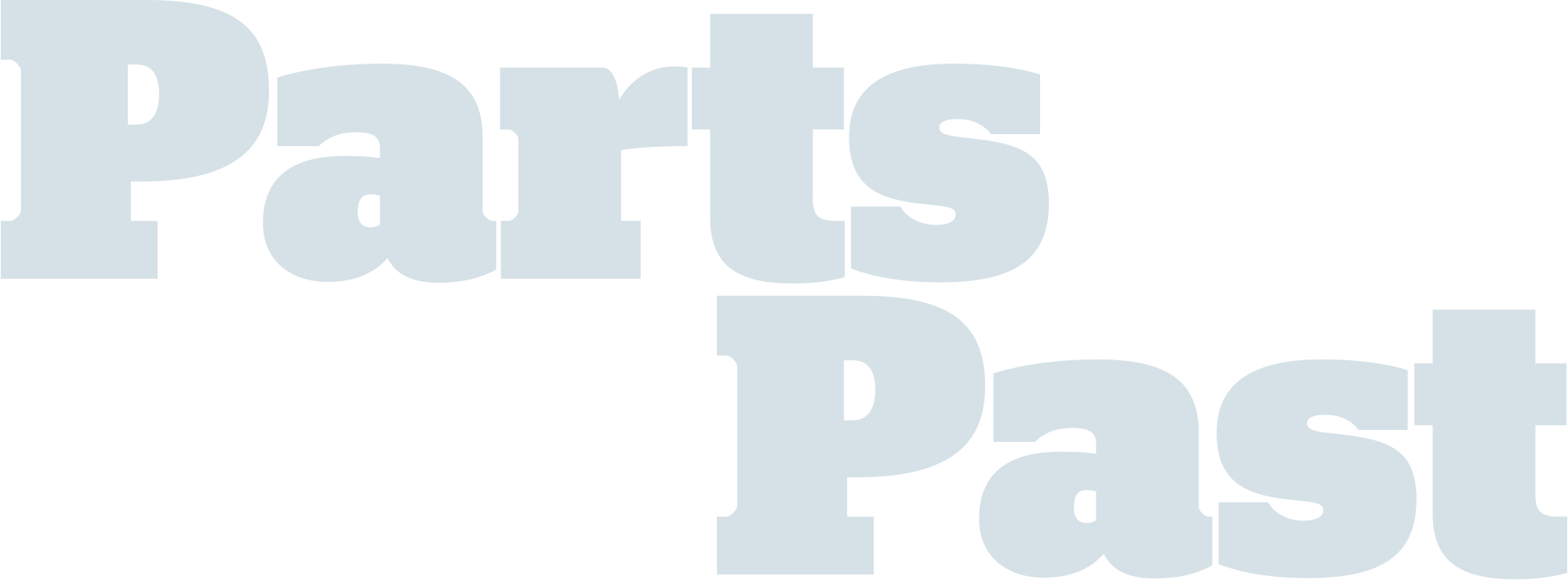
1934 Ford
Door
Sheetmetal
Die-Cast Trim
THE GAUGES
in Your 1955
& 1956 Chevy
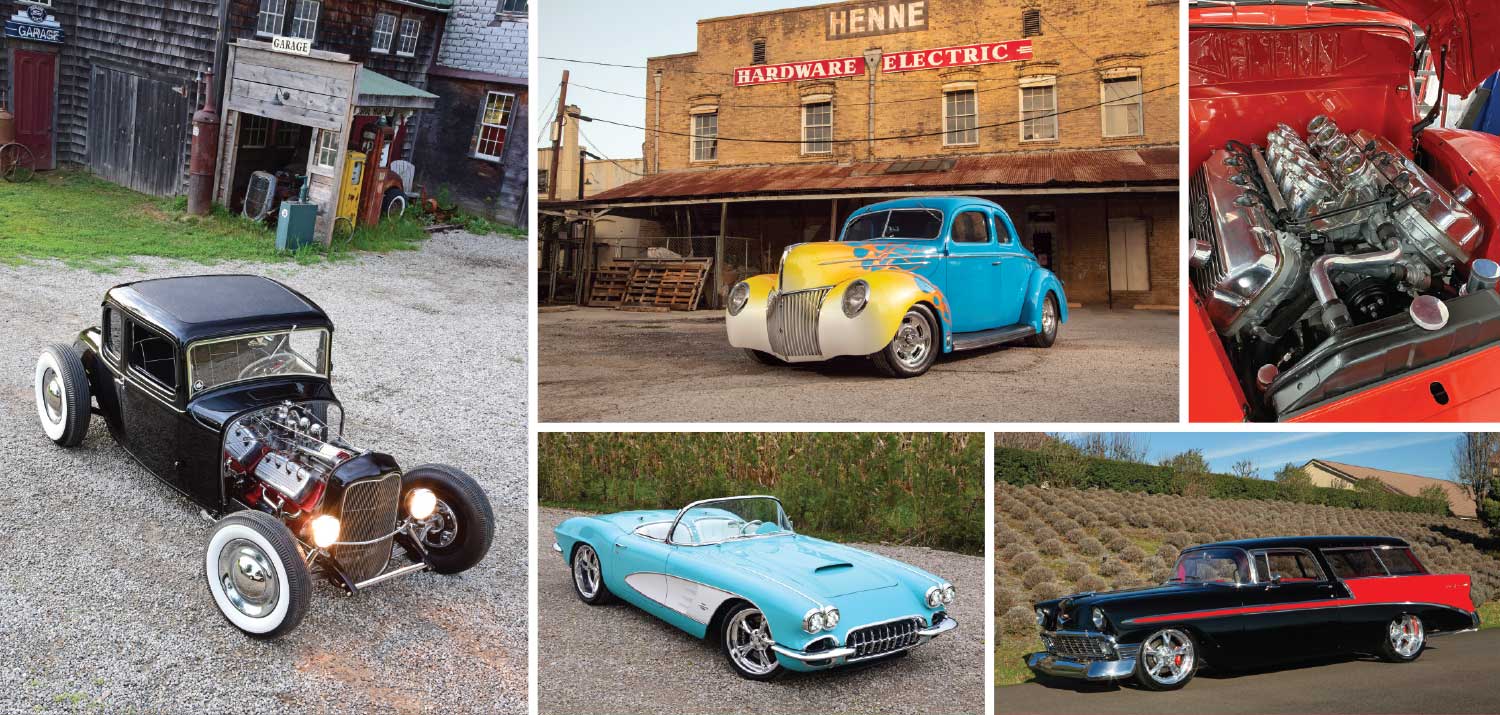

By Brian Brennan
Photography by John Jackson, Video by Chad Lunsford
By Chuck Vranas
Photography & Video by the Author
By Brian Brennan
By Brian Brennan
Photography by Chadly Johnson, Video by Loren Haleston
By Chuck Vranas
Photography & Video by the Author
By John Gilbert
Photography by the Author & Tim Sutton
Video by Tim Sutton
By Ron Ceridono
By Brian Brennan
Photography & Video by the Author
By Gerry Burger
Photography by the Author
By John Gilbert
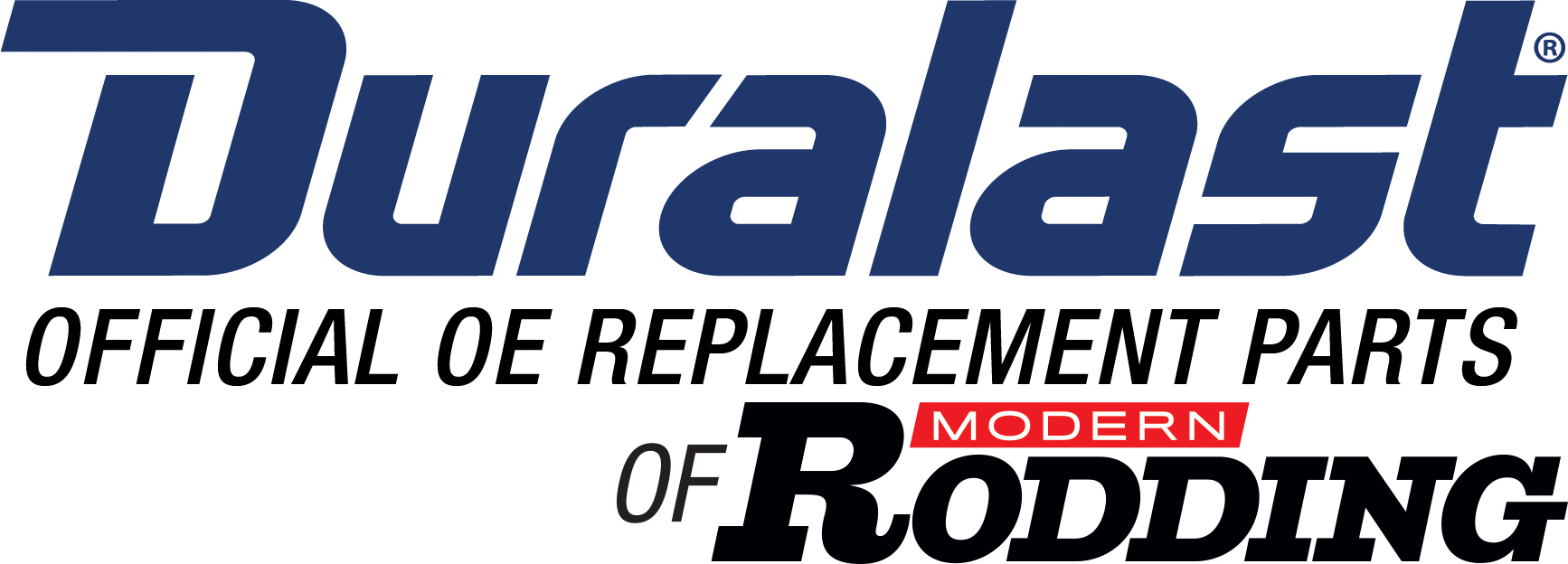

BRIAN BRENNAN
bbrennan@inthegaragemedia.com
TIM FOSS
tfoss@inthegaragemedia.com
YASMIN FAJATIN
yfajatin@inthegaragemedia.com
SARAH GONZALES
sgonzales@inthegaragemedia.com
ROB MUNOZ
Wes Allison, Rodney Bauman, Gerry Burger, Tommy Lee Byrd, Ron Ceridono, Michael Christensen, Ron Covell, Grant Cox, Dominic Damato, John Drummond, Eric Geisert, John Gilbert, Joe Greeves, John Jackson, Chadly Johnson, Barry Kluczyk, Scotty Lachenauer, Ryan Manson, Josh Mishler, Todd Ryden, Jason Scudelleri, Chris Shelton, Tim Sutton, Chuck Vranas, John Winter — Writers and Photographers
AllChevyPerformance.com
ClassicTruckPerformance.com
ModernRodding.com
InTheGarageMedia.com
Mark Dewey National Sales Manager
Janeen Kirby Sales Representative
Patrick Walsh Sales Representative
Travis Weeks Sales Representative
ads@inthegaragemedia.com

The Modern Rodding trademark is a registered trademark of In The Garage Media.
ISSN 2692-2371 (print)
ISSN 2692-238X (online)
Send address changes to In The Garage Media, 1350 E. Chapman Ave. #6550, Fullerton, CA 92834 or email ITGM at subscription@inthegaragemedia.com. Periodicals postage paid at Fullerton, CA, and additional mailing offices.

 By Brian Brennan
By Brian Brennan confess I may have borrowed the title for this editorial directly from the late LeRoi “Tex” Smith. To be on topic it was from his editorial as it appeared in the Nov. ’89 issue of Hot Rod Mechanix. The title and, maybe, the premise of the editorial may be borrowed but the collection of words and ideas to follow are sorta mine.
I’m guessing in some ways I’m no different than any number of hot rodders who peruse old magazines. It’s fun to see what was popular back then and how our hobby has morphed into what it is today. Frankly, much hasn’t changed, yet a great deal has. That brings me to the crystal ball segment—trying to guess what’s next.
In gathering my thoughts (and Tex’s) I sought another ancient one, Jerry Dixey, who was able to help me with the issue of HRM in question for my research. Dixey is now full bore with The Hot Rod Paper Company, buying and selling all manners of vintage magazines, catalogs, posters, and more. (Thanks to Jerry and should you want to sample his offerings, call 800-676-3026.)

 Art Morrison Enterprises
Art Morrison EnterprisesKnown for their very popular GT Sport line of “bolt-on” chassis, this line has expanded to a dozen popular series of cars and trucks. They allow the builder to essentially unbolt the vehicle body from the stock frame and slide in a sophisticated new chassis that provides improved ride, handling, and stance. With an eye to the do-it-yourself homebuilder, AME’s catalog contains numerous chassis and suspension components and essential tools.
AME also offers a dozen front and rear suspension options with a lineup of 2×4 and 2×3 subframes that are CAD-engineered for any application. Highlighting them is AME’s exclusive Multi-Link IRS that comes with a choice of two centersections and three cradle options. And given the company’s long history, AME has hundreds of vehicles in its massive database to expedite subframe projects. Happy 50th!
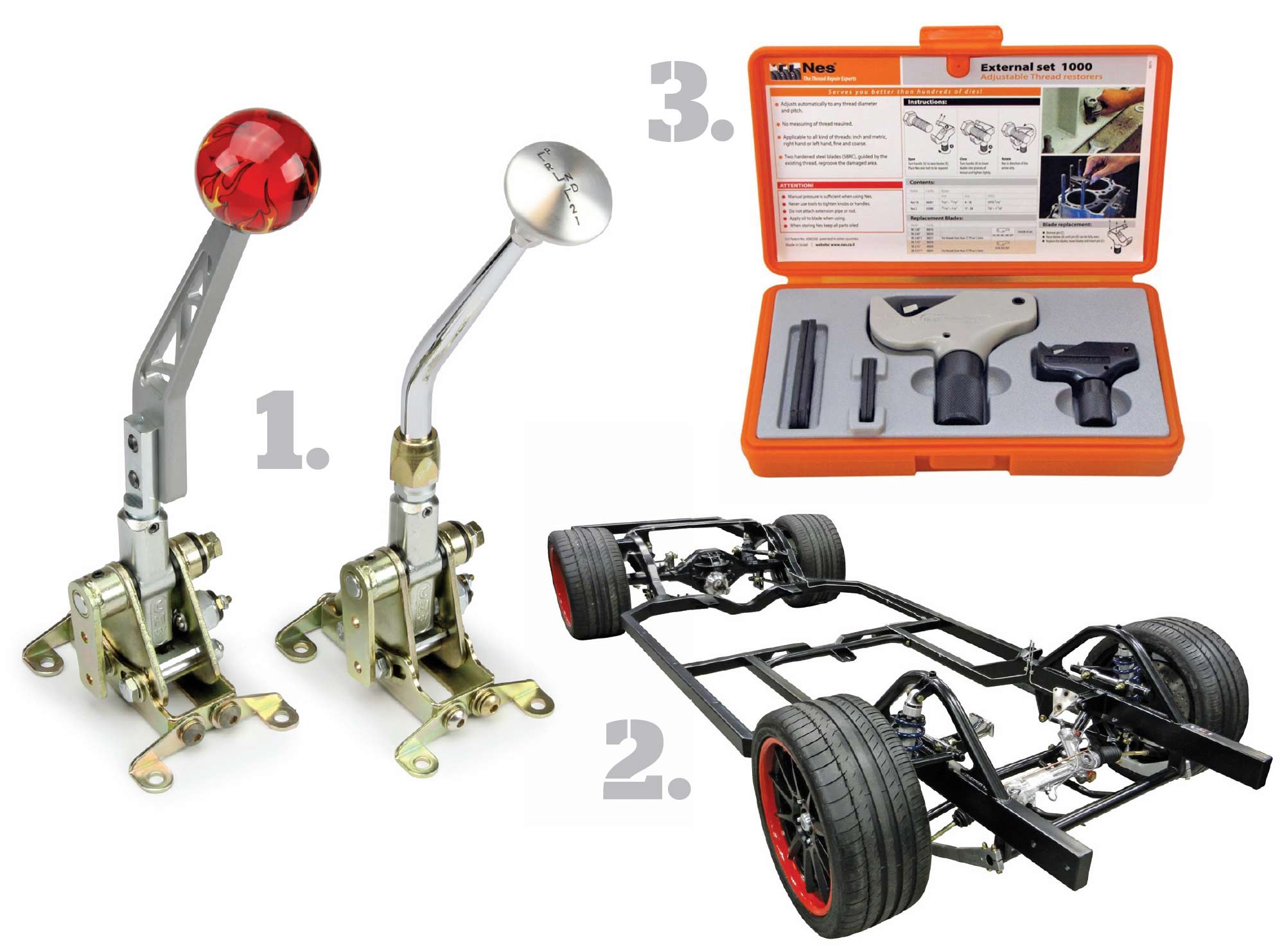
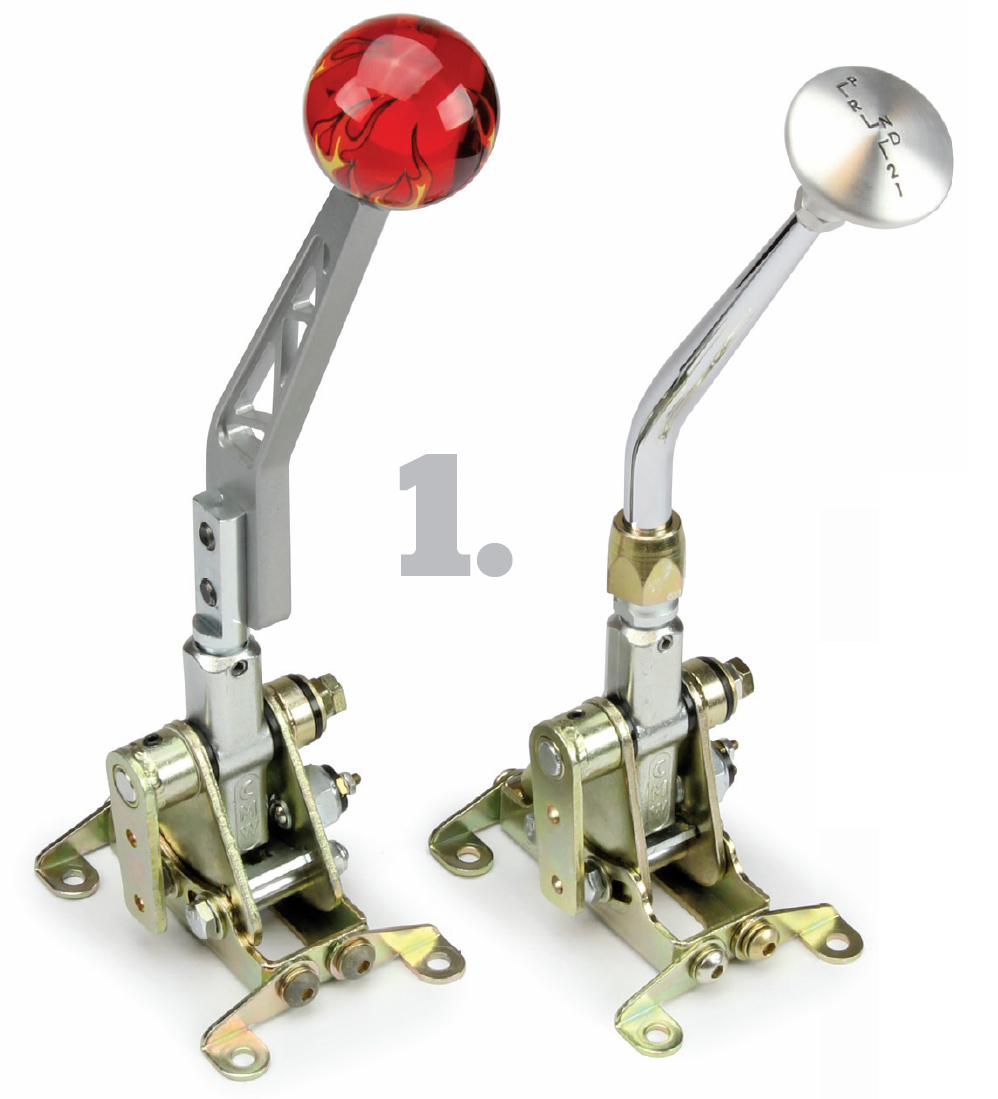

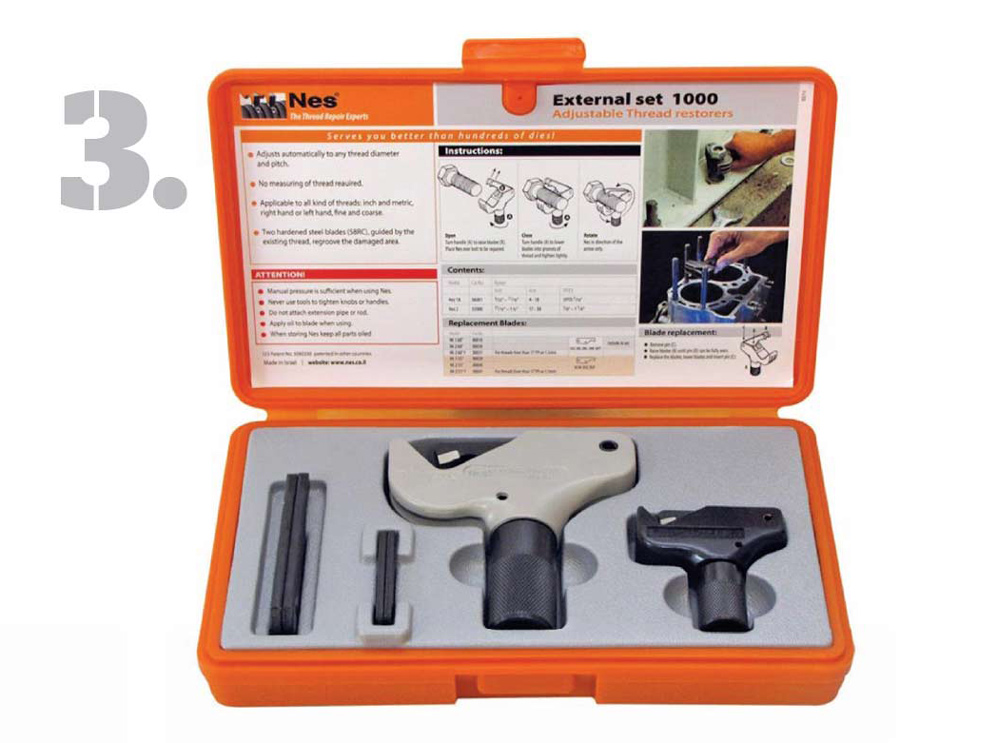
The shifters are available as complete assemblies (with lever and knob) or can be purchased separately to work with aftermarket levers that have a 7/8-inch bolt spacing mounting scheme, such as TREMEC-style shifter levers.
The floor mount gated shifters can be case mounted or converted to cable operation with optional conversion kits and are available for most common GM, Ford, and Chrysler transmissions.
The front suspension features tubular upper A-arms fit with needle bearing and are engineered with separate camber and caster adjustments while a triangulated four-bar system is used in the rear. The chassis also incorporates longer coilovers than other chassis at all four corners. This helps produce optimum ride quality with a low stance.
Available with mounts for small- and big-block Chevys, the W-block, and LS/LT V-8s along with adjustable transmission mount.
Nes designed the Thread Repair Tools to last as each one is made from HSS metal that’s hardened to Rockwell specifications for extra durability; the blades are replaceable.

 Photography by John Jackson
Photography by John Jackson Videography by Chad Lunsford
Videography by Chad Lunsfordt was September of 1968 and the end of an era for the first-gen Camaro was in sight. The 1969 Camaro would, in a matter of time, be the longest production run of any of the early Camaros. There were 243,085 1969 Camaros manufactured, making it the most produced of the first-gens.
“But that was then and this is now,” as the saying goes. Tim and Angie Wheeler are the very proud owners of this one-of-a-kind 1969 Camaro and are gratified with the work performed by the craftsmen under the watchful eye of Steve Cook at Steve Cook Creations (SCC), both located in Oklahoma. The team at SCC developed the style and performance by skillfully blending the fabrication, construction, body- and paintwork, wiring, and final assembly into a rolling piece of art. The SCC team was made up of Charles Collier, Ted Davis, Kevin Smith, Travis Cannon, Will Bailey, Alan Childers, Mike Cook, Kim Cook, and Steve himself.
1969 Camaro Reveals it All
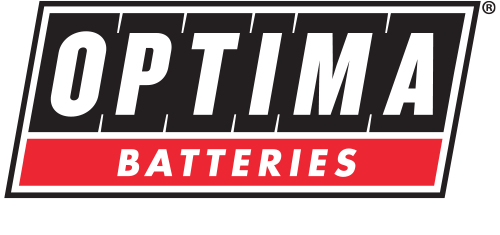

To produce all of that rumble from within this ride was going to need an intoxicating V-8 and a chassis to “hold it.” Making sure all of that horsepower got to the ground and the drive was everything it should be, the motorvation came by way of Don Hardy Racing (DHR). DHR stroked an LS3 to a forceful 418 cubes crowned with aluminum heads then capped with Clayton Machine Works by Lokar valve covers, sporting 10.8:1 compression, a custom-grind DHR cam, and the use of ARP hardware to keep all those big-ticket components tightly packaged. Lastly, all the reciprocating elements were painstakingly balanced by DHR.
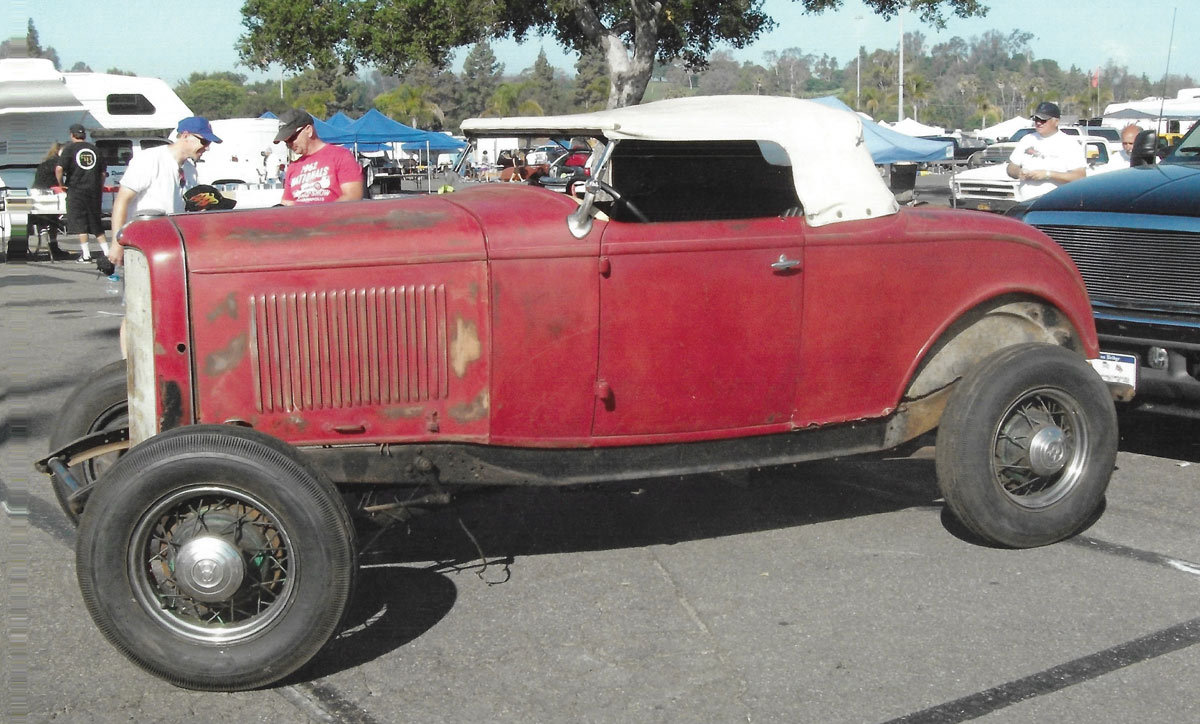
 Photography By THE AUTHOR
Photography By THE AUTHORt’s often said there’s a right way and a wrong way to do everything. While that may hold true in many instances, when it comes to building hot rods there is a third option, the Dennis and Matt Lesky way at Ionia Hot Rod Shop (IHRS).
We first met Dennis in 1994 at the National Hot Rod Association’s 40th U.S. Nationals. He had driven his chopped 1932 sedan to the event, the former B/Gas drag race car was unmistakable with its vintage orange finish and the name “Regret” emblazoned on both doors. Over the next few years we followed some of the hot rod projects Dennis was involved with while still working at General Motors as a journeyman welder and realized he was creative and immensely talented. Perhaps owing to his familiarity with production parts, Dennis was becoming known for creating early chassis components that looked like they were original equipment.
When Dennis retired from GM he decided to pursue his passion for creating unique hot rods along with his son, Matt. Evidently in the Lesky family tree this acorn didn’t fall too far away as Matt’s interest in hot rods started early in life. After high school his abilities were honed by working in tool and die and fabrication shops and those skills would prove to serve him well when he began working with his father in 1999. Together the talented father-and-son team opened IHRS in 2000 and quickly developed a reputation among hot rodders in the know for innovation and craftsmanship.

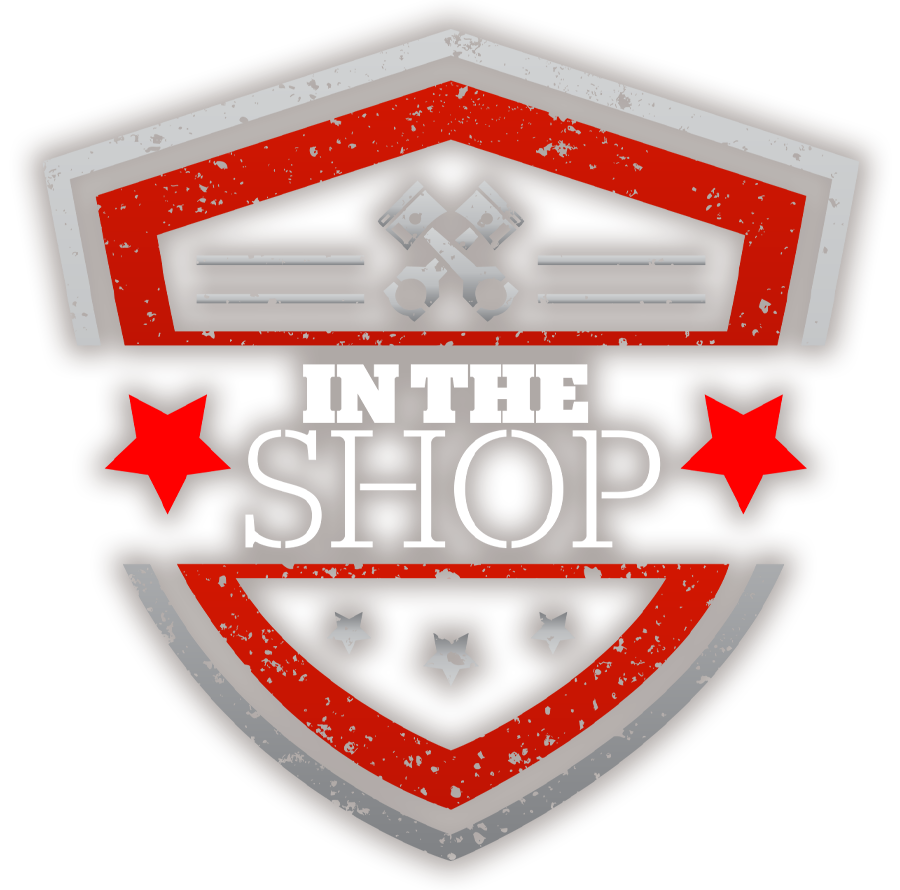

 Photography by THE AUTHOR & TIM SUTTON
Photography by THE AUTHOR & TIM SUTTON Videography by TIM SUTTON
Videography by TIM SUTTONollywood Hot Rods’ mantra “Respect Tradition” doesn’t mean hot rods the Burbank, California, shop builds have to adhere solely to the way things were once done; to the contrary, it’s a mission statement to guide the future. The handcrafted steel bodies of Hollywood Hot Rods’ creations exude nostalgia with styling cues evoking an era gone by—but focus on the underpinnings and it’s a story of modern upgrades concealed in a traditional-appearing package.
The saga of Hollywood Hot Rods is one that began for Troy Ladd at age 16 when he was given a 1966 Ford Mustang that needed a lot of work. At this point in Troy’s life he wasn’t a gearhead, but that was soon to change. Had Troy’s first car been something along the lines of a stodgy Rambler four-door sedan there might never have been a Hollywood Hot Rods, but fortunately the coolness of owning a V-8–powered Mustang in high school sparked Troy’s interest in cars.
 PHOTOgraphy BY THE AUTHOR
PHOTOgraphy BY THE AUTHORnless you just so happen to have a treasure trove of vintage parts stacked on shelves in your shop it’s more than likely you’ll have to go on a quest to source the period-perfect parts to build the traditional hot rod of your dreams. For Don Demers, of Rochester, New Hampshire, he stepped into a 20-year journey gathering all the bits to build the exceptional East Coast–styled 1932 Ford five-window channeled coupe displayed here. From waking up at dawn to canvas endless swap meets, following up on leads from friends, and avidly cruising the web, he persevered until he obtained everything needed to take on the build. It gets even better, as he was gathering parts for not one but two Deuces.
As fate would have it, along the way he met local hot rod builder Howard Towne who shared his ideas on just how cool it would be to bring his East Coast–styled vision to life. Soon after Don began unearthing his treasures, bringing them to Howard’s shop to get started. One of the pieces secured at a local swap meet was an original Deuce frame that had been Z’d hard back in the day. Howard, along with team member Geno Proulx, stripped it clean and gave it new life by first adding a Model A front crossmember, modified center X-member, and a narrowed 1934 Ford crossmember out back. They followed by removing the original Z and adding a 6-inch S-type kick. Out back a 1948 Ford rear was rebuilt and packed with 1940 Ford axles spinning 3.78 gears. It’s suspended in place by 1940 Ford radius rods complemented by a transverse spring with reversed-eyes and Pete and Jakes tube shocks. Up front a 4-inch dropped original Deuce axle with 1940 Ford spindles was deftly matched to a 1940 Ford transverse spring with reversed eyes, Pete and Jakes hairpins, and chrome tube shocks. When it’s time to drop anchor, a 1940 Ford master pushes fluid through steel lines to matching Ford binders at each corner. Linking it to the street you’ll find original 16-inch Ford steelies with vintage caps and rings wearing a classic Firestone/Coker set of big ’n’ little wide whites.

here are hot rods and then there are hot rods. What does that mean? Rick Love of New Braunfels, Texas, is no stranger to our hobby, its industry, nor driving his homebuilt 1939 Ford Deluxe coupe from event to event since 1984. The Grabber Blue and flamed 1939 Ford coupe has ushered Rick, whether it be coast-to-coast or state-to-state, numerous times as he covers the rodding world, helping car guys everywhere maintain their cool. Rick is the president of one of the oldest, largest, and most reputable manufacturers in our hobby, as the name Vintage Air is synonymous with air conditioning throughout our industry.

here are hot rods and then there are hot rods. What does that mean? Rick Love of New Braunfels, Texas, is no stranger to our hobby, its industry, nor driving his homebuilt 1939 Ford Deluxe coupe from event to event since 1984. The Grabber Blue and flamed 1939 Ford coupe has ushered Rick, whether it be coast-to-coast or state-to-state, numerous times as he covers the rodding world, helping car guys everywhere maintain their cool. Rick is the president of one of the oldest, largest, and most reputable manufacturers in our hobby, as the name Vintage Air is synonymous with air conditioning throughout our industry.
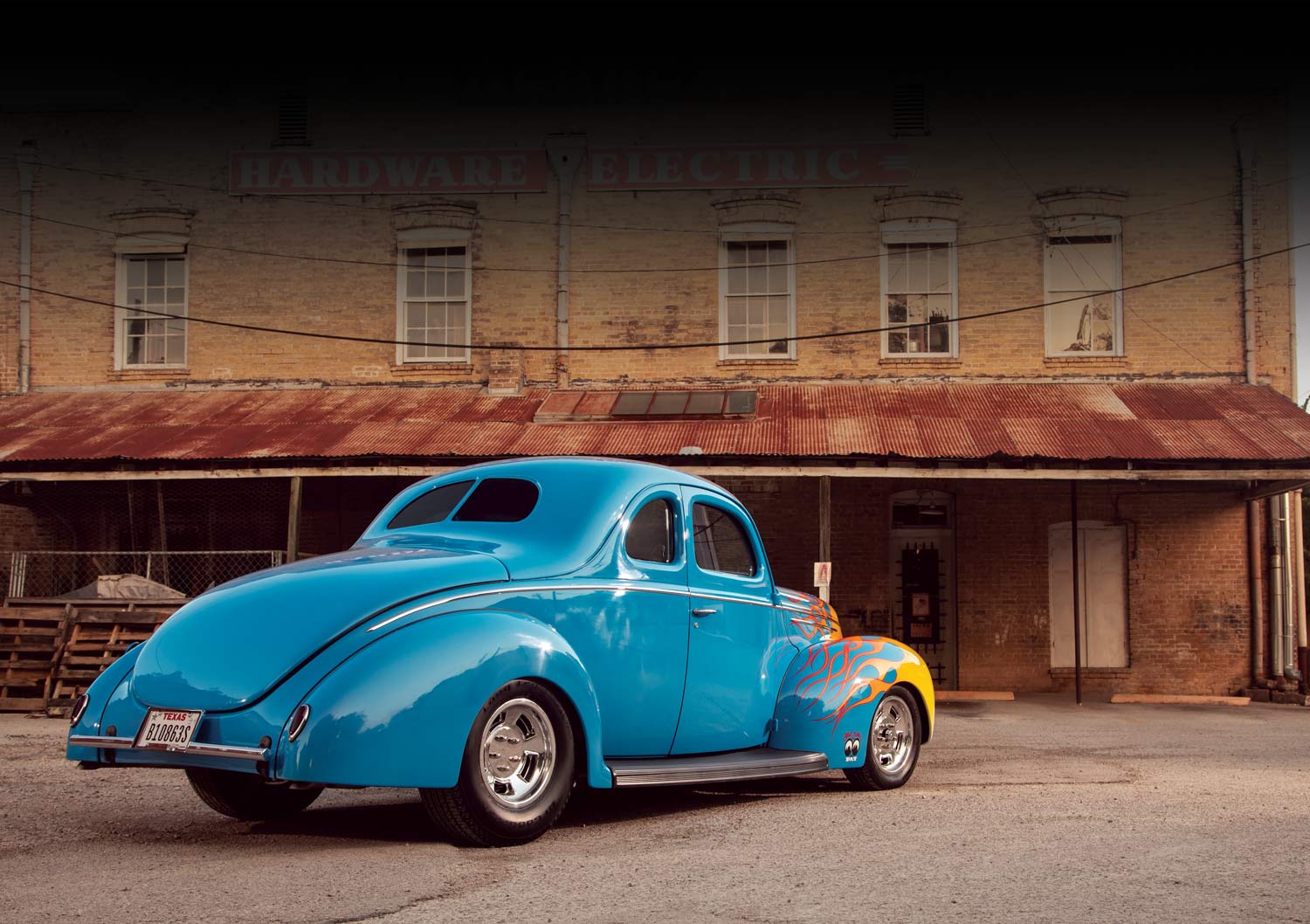
“Since I was young kid … in upstate New York, I had always thought the 1939-1940 Ford coupe was one of the best-looking hot rods there was. After I sold my 1940 Pontiac at the Street Rod Nationals in 1984, I decided I really wanted to build one—and it had to have a killer set of flames. I went to the NSRA Nats North in Detroit and found a somewhat-faded black coupe sitting by its lonesome with a small For Sale sign. The guy I bought it from was the second owner and he had owned it since 1970 and had turned it into a street rod in 1972 and driven it ever since. The black paint was shot over the original green. Despite being in the north its entire life, it was rust-free and still had all of its original sheetmetal.”
(Quick story from Modern Rodding freelancer Gerry Burger: I was with Rick when he bought the 1939 at the Nats North. It was black with burgundy velour interior—that faded to pink—but a very solid car. We looked it over carefully and Rick fretted about it all weekend before finally pulling the trigger. Now, Rick isn’t exactly famous for throwing money around so you can imagine what it was like to part with that large sum of money.)
 Photography & Videography by THE AUTHOR
Photography & Videography by THE AUTHORf there ever was a hot rod that rodders wanted to alter, yet at the same time they know it’s probably best to leave it alone, it’s any year of the Tri-Five Chevy. It seems the more rodders tinker with the Tri-Five the more they realize that Chevrolet designers got it right the first time. And the same goes for the inside of these cars with their beautiful dashes; sometimes it’s best to leave well enough alone.
If you want to start an epic argument with other Tri-Five lovers, just make the statement: “The 1955 Chevy is head and shoulders better looking than a 1956 or 1957.” Interestingly this desire to touch or not to touch applies both to inside as well as the outside styling. The Tri-Five instrument cluster in the 1955 and 1956 Chevy are unique and were well thought out. Yet, today’s rodder is just itching to make his 1955 or 1956 personalized and more to his (or her) own liking.
To help with this desire we have come across a way to give rodders what they want—the ability to tinker and at the same time not screw up a good thing. Enter Classic Instruments (CI) and their Bel Era III gauges that are designed specifically for the 1955 and 1956 Tri-Five Chevys. The cluster and glass lens arrives ready to install in your bezel. Should you need a bezel, a great place to source this would be Danchuk. (The Bel Era III gauge has already taken home the gold from the American Tri-Five Association with a Best New Product award.)

 Photography BY Chadly Johnson
Photography BY Chadly Johnson  Videography BY Loren Haleston
Videography BY Loren Halestonany of us have lifelong dreams on what our ideal hot rod should be. Tom Morehouse of Klamath Falls, Oregon, is no different than thousands of other hot rodders—he has spent a lifetime dreaming about owning a Nomad. Apparently dreams do come true, as Tom now has this beautiful 1956 Chevy Nomad from the shop of MetalWorks Classic Auto Restoration in Eugene, Oregon.
Tom tells us that he first joined the Classic Chevy Club back in 1977 and was a member for many years. Time passes and dreams are doggedly worked on, no matter how much time it takes, and Tom was able to begin this build back in the summer of 2001. In the meantime, he spent his time looking for just the right Nomad to launch his dream project. He settled in on this particular 1956 Chevy Nomad because it was straight, it was complete, and it was rust-free—he hit the trifecta for any of us building vintage tin. He purchased the car from a hobbyist who finally one day admitted he had one too many projects. (All of us have or will be there someday.) According to the VIN, the Nomad was an original California car built in Oakland around December 15, 1955. From this auspicious beginning it would eventually end up in a used car parking lot in the Sacramento area back in 1996 and that’s when its next life began.
It was now time to begin the build in earnest. It didn’t take Tom long to realize the type of car he wanted was outside the scope of his skill sets. Once the body was dipped, to get rid of decades-old baddies, he spoke with shop manager Matt Powell of MetalWorks on a course of action. Powell knew Tom wanted a real hot rod, since the Nomad was sans original engine and transmission there was little reason not to go fully modern. During the conversation it was decided that in order to get the job done the original chassis (frame and suspension) would have to be parked in a corner and a new chassis put in its place.
 Photography BY THE AUTHOR
Photography BY THE AUTHOR

 Photography BY THE AUTHOR
Photography BY THE AUTHORuilding a hot rod of any era is a stream of choices—some big, some small—but they all contribute to the finished package. One thing we learned early on was to pick a theme and make every decision fit that style. My latest project is a 1936 Ford phaeton being built as an early ’50s hot rod/custom. Many cars of that era blurred the lines between rod and custom with performance under the hood and some custom touches and paint on the outside. That is the very theme of our 1936, with a built Flattie underhood and a conservative custom approach on the outside.
We’ve recently been doing the bodywork and while stacking parts on the shelf (all neatly marked for the memory impaired) we came across the original grille ornament. The ornament was in overall good condition with the V-8 emblem intact. However, two holes drilled in the piece told us a greyhound had once adorned the piece. While greyhound ornaments are cool, in keeping with the theme of the car, we thought a simple bullnose ornament from Speedway Motors would be a quick-and-easy solution. But then we began to think about making our own bullnose piece, but with a custom twist. We wondered about grinding down the finned portion of the ornament to a lower profile giving us a “semi-bullnose” look.

 Photography & Videography THE AUTHOR
Photography & Videography THE AUTHORuch to the horror of automotive purists, there’s nothing quite like tearing into your favorite classic Chevy to up the ante from bone stock to highly modified. Such is the case with Shawn Freer’s 1961 Chevy Corvette from Midland, Ontario, Canada, presented for your viewing. Sure, a stock Corvette handles great and performs well in its original form but imagine turning up the heat with an explosive combination of an updated chassis and LS power to bring it into the new age.
Since the start, Shawn was always drawn to the sound of hopped-up muscle cars as they rolled the strip at Wasaga Beach where his parents owned and operated an IGA store. While working there during his formative years, he was mesmerized on a daily basis thanks to the changing assortment of hot rods, customs, and muscle cars that were always in the store parking lot. Surrounded by the sights and sounds it was easy to see that his performance path was set leading him to his first car, a 1975 Camaro by the time he was 15 years old. By wrenching on the car he learned the basics while cruising the strip, achieving the full experience.
There’s always one ride that invades your mind, leading to plenty of sleepless nights as you imagine yourself behind the wheel. For Shawn it was one particular C2 Corvette belonging to his good friend Scott Campbell’s dad. Pure fantasy at the time, he never imagined that he would ever own one. As the years passed though there were a number of cool rides to follow but finally he landed his own 1968 and then a 1965 Corvette. Having always appreciated the classic design elements of the C1, Shawn finally made the decision to start looking for a suitable donor car to start his next project with. After scouring online ads and looking at a number of unsuitable projects, he located a 1961 Corvette in his hometown. The car, an original, non-numbers matching four-speed model, had been hidden away by the owner in his barn, having not seen the light of day for years. Seeing that the car was both a driver and complete, a deal was made for the title.
 Photography & Videography THE AUTHOR
Photography & Videography THE AUTHOR
 Photography By THE AUTHOR
Photography By THE AUTHORGraft
Rusted-Out Steel the
Right Way
 Photography By THE AUTHOR
Photography By THE AUTHORGraft
t’s always a chuckle when a non-car guy walks up to the owner of a recently restored or freshly built hot rod and remarks, “I didn’t know you could still buy one of those cars brand new.” Where does one start? Do you tell the guy he’s looking at five old cars cut apart and welded back together to create the car he’s admiring, or just smile and say thanks?
There are a lot of different projects a first-time DIY guy can do without needing tons of equipment or expertise to make desired repairs or upgrades to his project car— but returning large, rusted-out areas into good-as-new sheetmetal isn’t one of them.
That said, this doesn’t mean a DIY guy can’t stand half a chance taking a shot at doing his own sheetmetal repair if he doesn’t mind making a serious investment in the right equipment and learning how it’s done. Or for that matter the hot rod shop that wants to expand the services they’re doing in-house.
View Index
View Index
